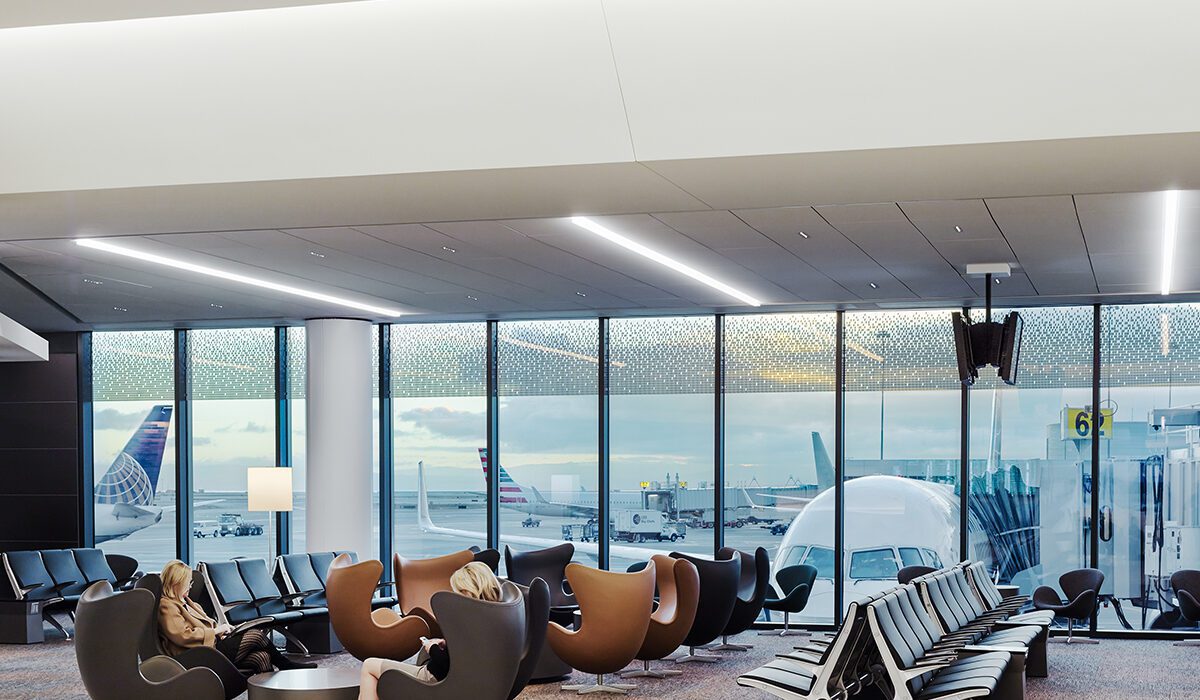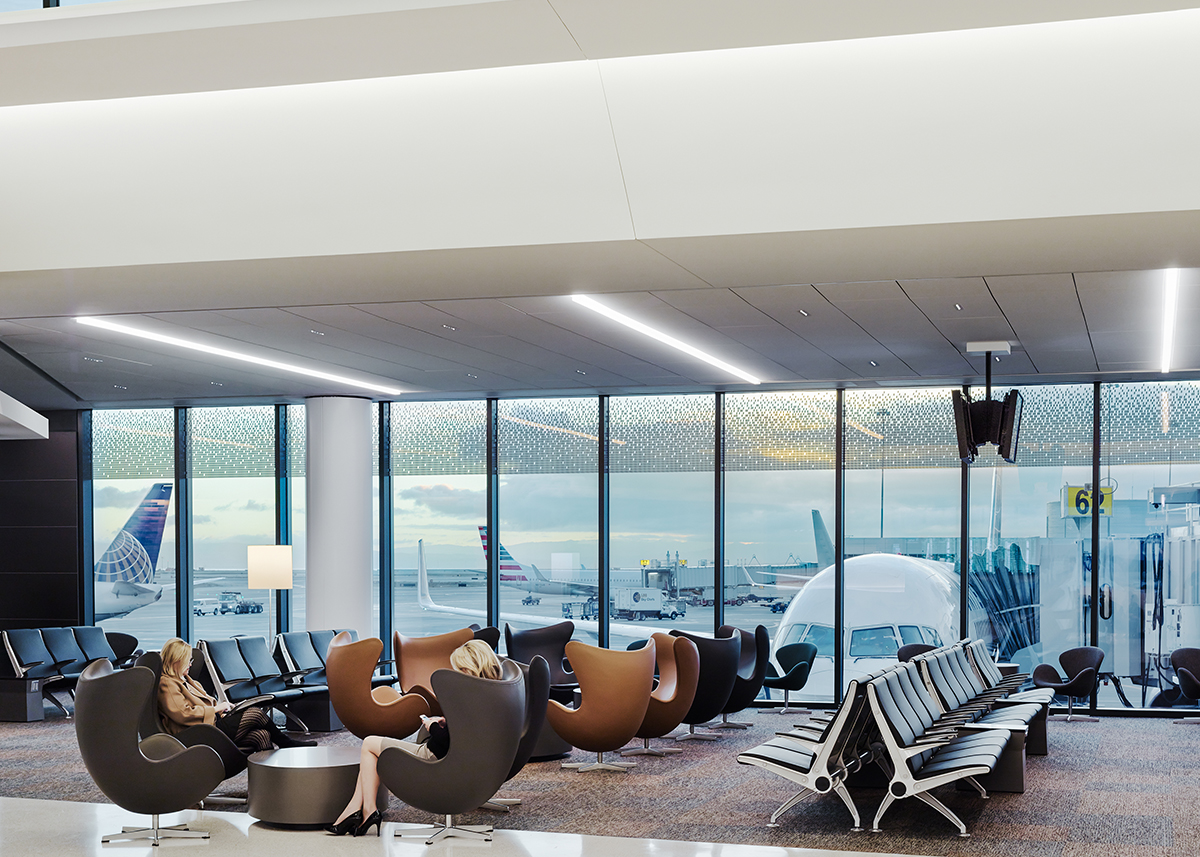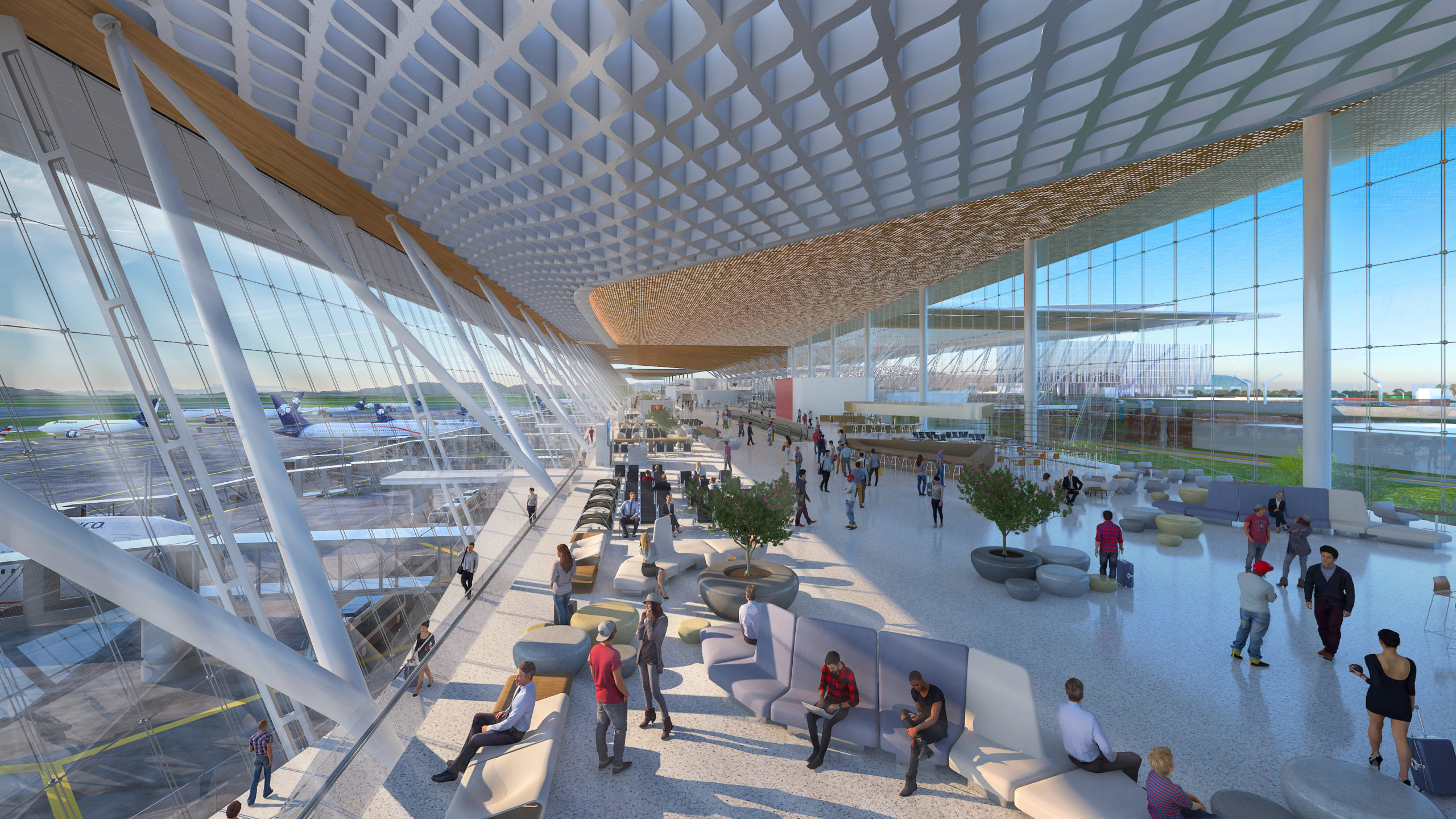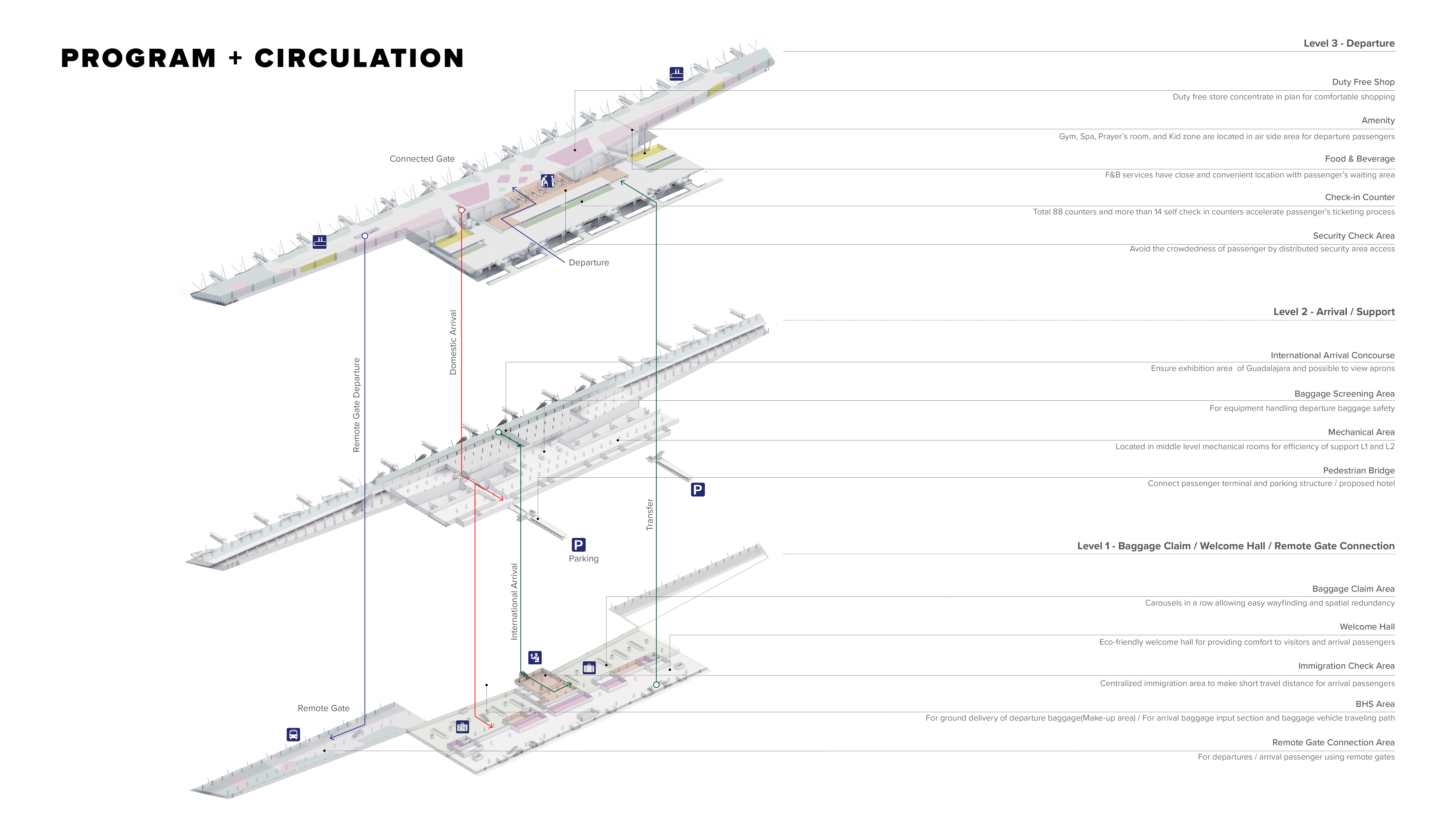An Architect’s Guide To: Office Design and Planning
Emma Walshaw is the founder of First In Architecture and Detail Library. She has written a number of books aiming to facilitate a better understanding of construction and detailing. First In Architecture is a website providing resources and guides for architects and students.
For many people, work is their life. They spend 40+ hours a week at the office and this time can be some of the most rewarding or most frustrating depending on how well your office space is set up. The planning of a workplace or office is not just about how the space looks, but also about what is important to employees.
There are many things to take into consideration as there are different factors that can impact productivity and employee morale. Here are just a few things to consider when designing a new office or workplace.

Plus X by Studio Egret West, Brighton, United Kingdom | Popular Choice, 2021 A+Awards, Coworking Space
A Changing Workplace
The shape of offices has changed over the last couple of decades, with office design becoming a way to attract talent, increase productivity and creativity, show off the companies modernity and get into architectural design websites and magazines. Google, anyone? In the 21st century, office design became fashionable.
Yet, with the era of Covid 19, work practices are rapidly changing. Suddenly, companies are not only offering flexible working hours, multiple work locations within one building, but also work from home. Only time will tell how long the work from home option continues.
These changes are leading to different new concepts for office design and a necessity for flexibility more than ever. Meeting the current needs of the organization is not the only challenge that designers face; they must also anticipate the company’s future needs and design with the adaptability required to fulfill them. Good office design has been attributed to improved health and wellbeing of employees, increased productivity, staff retention and sense of community. All the more reason to invest time and effort in creating a great office design.

Plus X by Studio Egret West, Brighton, United Kingdom | Popular Choice, 2021 A+Awards, Coworking Space
Office Planning
There are many variables and factors that will inform a new workplace design and this guide cannot cover the full gamut. However, we will explore some of the design considerations and key points to address when designing a new office.
Establishing the requirements of the organization that will use the office will be one of the first aspects of the design. At this point, input from many of the end users will be useful in creating a picture of the workplace experience that the company are looking to achieve.
How Will the Office Be Used?
What are the aims and objectives of the organization? What different duties and roles are carried out in the organization and how might that change in the future? How do the employees work now, and how do they want to work? What do the employees need in order to be as effective as possible? Do visitors come to the office?
How Does the Company Want To Portray Its Brand?
Does the organization want to show its brand and personality in the design of the office? What kind of brand values and messages does the company want to portray to its employees and visitors? Many more questions can be asked about the culture of the company and more to gain a deep understanding of who the company is and what they are trying to achieve.

New Headquarters Scott Sports by IttenBrechbühl, Givisiez Switzerland | Photos: Upper by Philipp Zinniker, Lower by Faruk Pinjo | Jury Winner, 2021 A+Awards, Office Building Mid-Rise (5-15 Floors)
Journey Design
Journey design is a large part of the early office design. This goes beyond considering the journey from the entrance of the building to your desk, and how you might get there.
Journey design is about understanding the experience, through all sensory factors, in each part of the building. How are people going to interact with the building? What will their experience be and how will they perceive the company? These questions apply to both employees and visitors.
Most offices can be separated into zones:
Arrival or Entrance Zone
First entry into the office for both staff and visitors. Staff could have alternative entrance in larger office buildings. The entrance is often welcoming and open to the public.
Visitor or Public Zone
The visitor zone is where meetings may take place, whether in a formal meeting room or cafe. The visitor zone consists of employees and people that don’t work for the company. Usually, in larger offices, the visitor areas are kept separate from the main staff working areas.
Working Zone
The working zone is accessible to staff only and usually will consist of office/desk space, meeting rooms and the core functions of the company.
Social Zone
The social zone allows for more informal meetings, refreshments and other activities that aren’t suited to the working zone. How the employees and visitors journey to and through these zones should be carefully considered.

New Headquarters Scott Sports by IttenBrechbühl, Givisiez Switzerland | Photo by Simon Ricklin | Jury Winner, 2021 A+Awards, Office Building Mid-Rise (5-15 Floors)
Spatial and Room Requirements
In addition to these types of questions, it is also important to establish spatial and physical requirements from the organization. In short, what rooms/spaces do they need, how many staff do they have, what size canteen will they need, how many sanitary facilities, and so on.
These spaces will perform a variety of functions. The functions will have an impact on how that space is designed. For example, if the offices require focus work, consideration will be taken in minimizing noise and creating a good working environment without distraction. Let’s look at the room types:
- Focus work: routine work, long durations
- Casual / informal: more mobile spaces, small short casual meetings
- Private / quiet space: concentration, confidential, reflection
- Group work: casual/information meeting spaces, group tasks, away from focus area
- Meetings: dedicated rooms for meetings, work, learning, interviews etc.
- Amenities: areas for refreshment, relaxation, social interaction, wellbeing
- Services: support services such as IT, cleaning, security
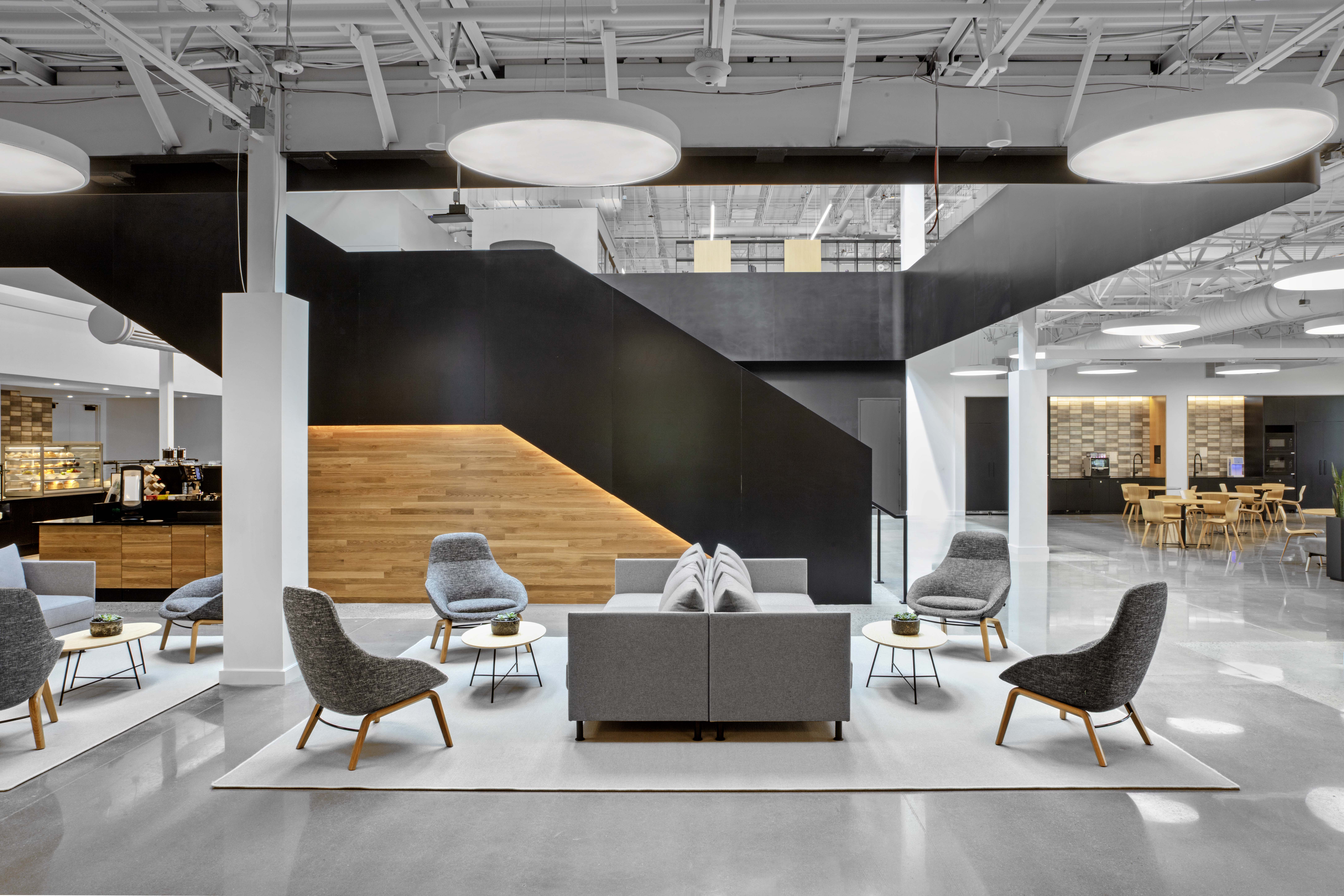
Kering Americas by HLW, Wayne, NJ, United States | Popular Choice, 2021 A+Awards, Office Interiors (>25, 000 sq ft)
Office Design Considerations
The following section will give general tips and pointers for good office design. Some of the suggestions below will be dependent on the size and nature of the office to be designed.
Accessibility and Inclusivity
All accessibility design standards should be met and exceeded where possible. Creating an inclusive and accessible office ensures it can be used by a wide and diverse range of people. Consider both visible and non visible disabilities and how the spaces can be used without the need for assistance. Spaces and facilities should be provided that avoid separation, segregation or unnecessary effort.
Flexibility
As mentioned earlier, offices are changing environments. The design must include flexibility to adapt to changes of the organization. Modular designs that are multifunctional can help to allow for these changes. Designs can also include options for easy upgrading as technology advances.
Safety and Security
Depending on the nature and location of the office, security measures are often an important consideration. Entry to the building itself should be welcoming and without obstruction, but it is often necessary to incorporate secure access to the non public areas. This should be done discreetly, and with the option of upgrading or altering as required.
Technology
Technology is a key part of a successful organization. Digital infrastructure must be integrated into the design early to ensure a strong workflows. Again, the technology must be organized and designed in such a way that upgrades are possible with minimal disruption.

Kering Americas by HLW, Wayne, NJ, United States | Popular Choice, 2021 A+Awards, Office Interiors (>25, 000 sq ft)
Employee Wellbeing
Working to conserve employee wellbeing can come in many forms. Work is a key part of our lives and it is important that employees feel supported and are given the opportunity and amenities to flourish. If an employee is feeling physically and mentally fit, they are more likely to feel engaged and driven in the workplace.
Provide an office that is comfortable, with a healthy working environment, along with good indoor air quality with a mix of natural and mechanical ventilation. Design facilities for reflection, and ensure the use of lighting, acoustics and colors reduce stress.
If appropriate, an onsite gym or social area can also be provided.
Lighting
An office contains a variety of spaces that fullfil different roles. The lighting design will need to reflect the different spaces. For example, the reception area may be designed to be light and bright and welcoming. While office spaces might have more focused lighting and measures to prevent glare. Quiet spaces and areas for reflection will have softer lighting. The lighting design of an workplace will enhance the mood and activities of the spaces. Lighting design incorporates both natural and artificial lighting techniques.
Acoustics
Similar to lighting design, the acoustics must be designed according to the spaces and functions carried out within those spaces.
For some open plan offices provide a challenge for some employees, as noise levels and distractions around them can have a negative effect on productivity. However, if an office is too quiet some report this to be a little unnerving.
Finding a good balance in the acoustics is important. Acoustic materials that absorb excess noise can help to improve communication between teams, improve privacy for private phone calls, and allow employees to focus better on complex or concentrated tasks.
Having a variety of spaces that are acoustically designed will allow for staff to select the space according to their requirements, ie, group discussion, formal meeting and so on.
Conclusion
Office design is a large topic and we’ve only scratched the surface here. The workplace has been changing over time and offices need to be flexible, considering how they will be used with employees of different generations who have varying needs for work-life balance. These considerations also include understanding what types of space are required in an office environment given that many people today don’t just use their desktop or laptop all day long at one location. We hope this blog post has provided you with some insight into getting started on your own journey towards designing an ideal workplace!
Browse the Architizer Jobs Board and apply for architecture and design positions at some of the world’s best firms. Click here to sign up for our Jobs Newsletter.



 Iturbide Studio by TALLER Mauricio Rocha + Gabriela Carrillo, Mexico City, Mexico
Iturbide Studio by TALLER Mauricio Rocha + Gabriela Carrillo, Mexico City, Mexico
 Cultural Center at Centro Educativo de Morelia by doho constructivo + Iván Marín Arquitectura, Morelia, Mexico
Cultural Center at Centro Educativo de Morelia by doho constructivo + Iván Marín Arquitectura, Morelia, Mexico
 Pavilion ( ) by MICHAN ARCHITECTURE, Kababie Arquitectos, Colectivo Seis and Taller Paralelo Mexico City, Mexico
Pavilion ( ) by MICHAN ARCHITECTURE, Kababie Arquitectos, Colectivo Seis and Taller Paralelo Mexico City, Mexico
 Casa UC by Daniela Bucio Sistos // Taller de Arquitectura y Diseño, Morelia, Mexico
Casa UC by Daniela Bucio Sistos // Taller de Arquitectura y Diseño, Morelia, Mexico


 1200 Bricks Little Chapel by S-AR, Santiago, Mexico
1200 Bricks Little Chapel by S-AR, Santiago, Mexico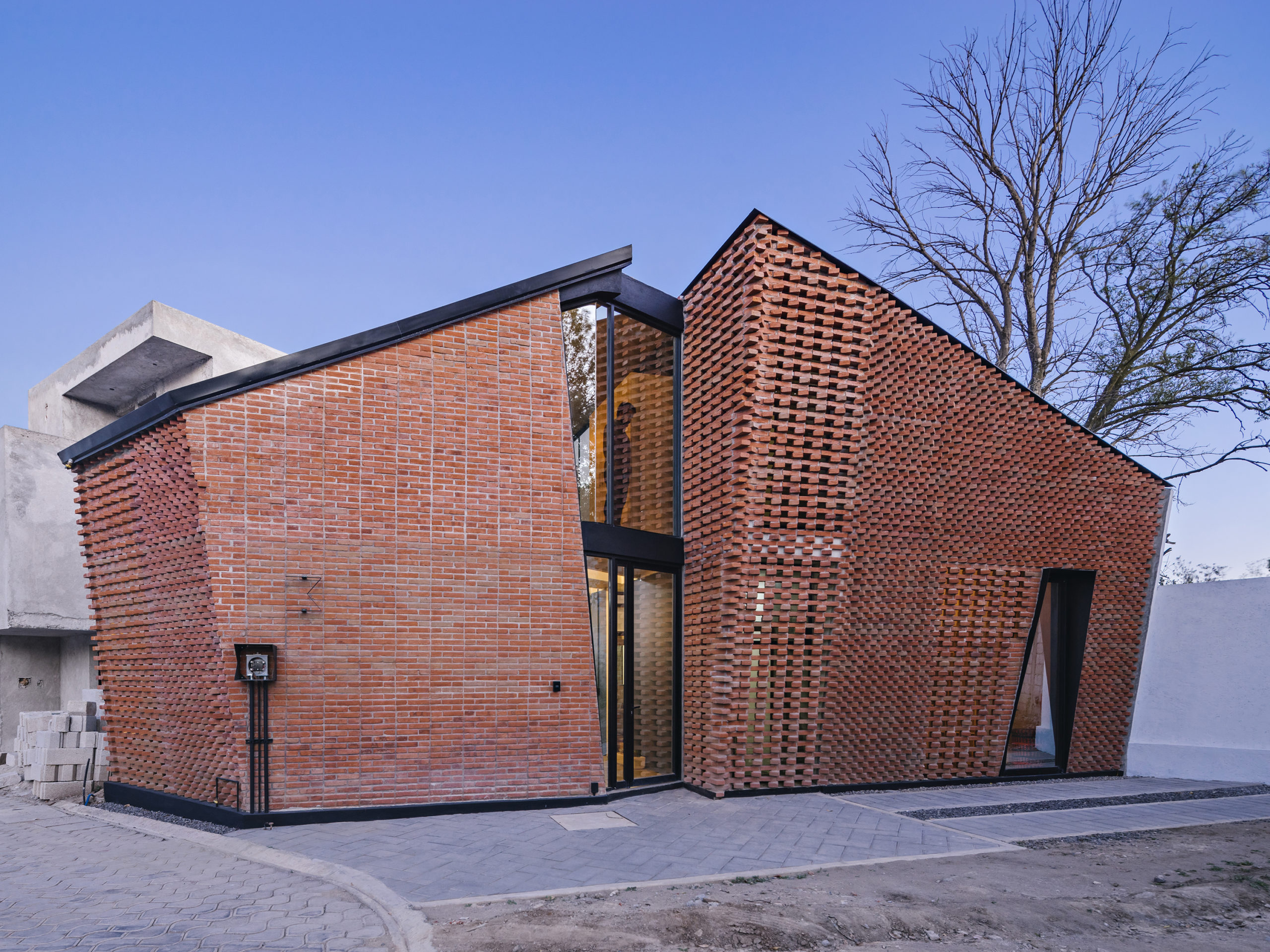
 Saint Peter House by Cafeína Design, Cholula, Mexico
Saint Peter House by Cafeína Design, Cholula, Mexico
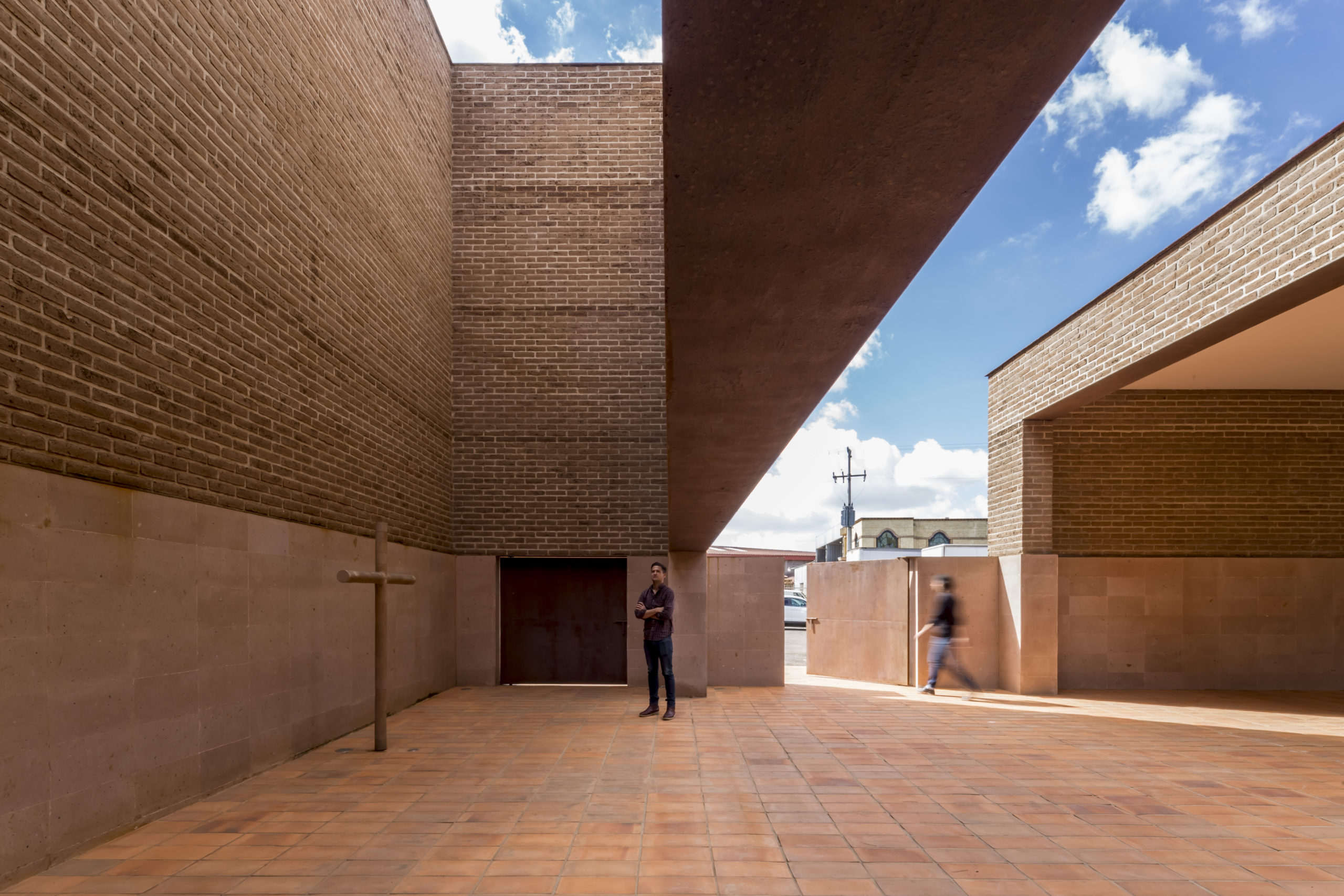

 Ruta del Peregrino Refugies by Luis Aldrete, Jal., Mexico
Ruta del Peregrino Refugies by Luis Aldrete, Jal., Mexico “This image is part of a set of images developed for a competition for the 7th bridge on Douro’s river in Porto, Portugal. Porto is a very foggy city, with a very peculiar light. We tried to embrace this atmosphere, alongside the idea of scales, between the old city and the new architecture.
“This image is part of a set of images developed for a competition for the 7th bridge on Douro’s river in Porto, Portugal. Porto is a very foggy city, with a very peculiar light. We tried to embrace this atmosphere, alongside the idea of scales, between the old city and the new architecture. “This image is part of a set of images done for the Environment Museum Design Competition, V.N. Gaia, Portugal. We got inspired by the natural materials like concrete and brick, of this very straight forward auditorium, and wanted to give this atmosphere of deep space, a hole on the ground like somewhere between Wieliczka Salt Mine and James Turrel.”
“This image is part of a set of images done for the Environment Museum Design Competition, V.N. Gaia, Portugal. We got inspired by the natural materials like concrete and brick, of this very straight forward auditorium, and wanted to give this atmosphere of deep space, a hole on the ground like somewhere between Wieliczka Salt Mine and James Turrel.” “In the cottage in the mountain, you don’t have to buy flowerpots and plant all kinds of flowers and plants in order to create a quiet and elegant environment like city people. There are countless flowers and plants in the mountains. As long as you set foot outdoors, you will enjoy countless fragrances and surprises. These beautiful messengers of nature breathe the breath of the mountains, enjoy the sunshine of the mountains, suck the rain and dew of the mountains, and bloom gorgeous and dazzling flowers.”
“In the cottage in the mountain, you don’t have to buy flowerpots and plant all kinds of flowers and plants in order to create a quiet and elegant environment like city people. There are countless flowers and plants in the mountains. As long as you set foot outdoors, you will enjoy countless fragrances and surprises. These beautiful messengers of nature breathe the breath of the mountains, enjoy the sunshine of the mountains, suck the rain and dew of the mountains, and bloom gorgeous and dazzling flowers.” “What happens when post-anthropogenic destruction of forests has necessitated a new paradigm of above-ground forestry labs, catalyzing the radiant hope for a flourishing of ecosystems of mycelium and plant growth? “Do Look Up” is predicated upon the anxieties of living and reconciling with the preceding age of environmental collapse and landscape desolation.
“What happens when post-anthropogenic destruction of forests has necessitated a new paradigm of above-ground forestry labs, catalyzing the radiant hope for a flourishing of ecosystems of mycelium and plant growth? “Do Look Up” is predicated upon the anxieties of living and reconciling with the preceding age of environmental collapse and landscape desolation. “The image depicts one of the icons of the city of Copenhagen, the Opera house, designed by the Danish architect Henning Larsen between 2001 and 2004. During my trip to the Danish capital I took some photos of it and used them as a reference to reproduce this personal work of mine. I focused my attention on reproducing a lighting that could emphasize not only the building but the whole context.
“The image depicts one of the icons of the city of Copenhagen, the Opera house, designed by the Danish architect Henning Larsen between 2001 and 2004. During my trip to the Danish capital I took some photos of it and used them as a reference to reproduce this personal work of mine. I focused my attention on reproducing a lighting that could emphasize not only the building but the whole context. “The Context: The Cipea house is located within a natural forest context in Nanjing, China, the introspective architecture brings the main focus inward allowing the organically shaped openings to simulate the shape of a traditional Chinese scroll cohabiting with the immediate landscape.
“The Context: The Cipea house is located within a natural forest context in Nanjing, China, the introspective architecture brings the main focus inward allowing the organically shaped openings to simulate the shape of a traditional Chinese scroll cohabiting with the immediate landscape. “He stopped at the edge of giant round space and looked up at the delirious structure towering beyond the entire landscape. The main ring rose in the last few months over 10 cm through the accelerating speed of rising water caused by massive iceberg melting. In everyone’s mind was if the height of the pillars is enough to protect them from an ongoing catastrophe. Floating City has been growing in the past decade extremely quickly, as the area of dry land was shrinking.
“He stopped at the edge of giant round space and looked up at the delirious structure towering beyond the entire landscape. The main ring rose in the last few months over 10 cm through the accelerating speed of rising water caused by massive iceberg melting. In everyone’s mind was if the height of the pillars is enough to protect them from an ongoing catastrophe. Floating City has been growing in the past decade extremely quickly, as the area of dry land was shrinking. “A house being swallowed by the sea
“A house being swallowed by the sea “The park is in an envisioned theme set in the 1960’s retro futuristic Latin America. Visitors can feel the experience of a ‘wild’ space where nature harmonizes with its architectural surroundings making it appear organic. Using landmarks that defined generations of happy memories as a source of inspiration it engages with the possibility of extension and adaptability with different influential settings of culture. The park has created lifelike androids that ‘act’ as the animals supplanting their real counterparts for education and entertainment purposes. Although it’s an engaging experience, people will still need to use their own ‘air purifiers’ because things are never what they seem. Tailored prevention inside the park is most important. One never knows what could happen… A reality not so different from our own.”
“The park is in an envisioned theme set in the 1960’s retro futuristic Latin America. Visitors can feel the experience of a ‘wild’ space where nature harmonizes with its architectural surroundings making it appear organic. Using landmarks that defined generations of happy memories as a source of inspiration it engages with the possibility of extension and adaptability with different influential settings of culture. The park has created lifelike androids that ‘act’ as the animals supplanting their real counterparts for education and entertainment purposes. Although it’s an engaging experience, people will still need to use their own ‘air purifiers’ because things are never what they seem. Tailored prevention inside the park is most important. One never knows what could happen… A reality not so different from our own.”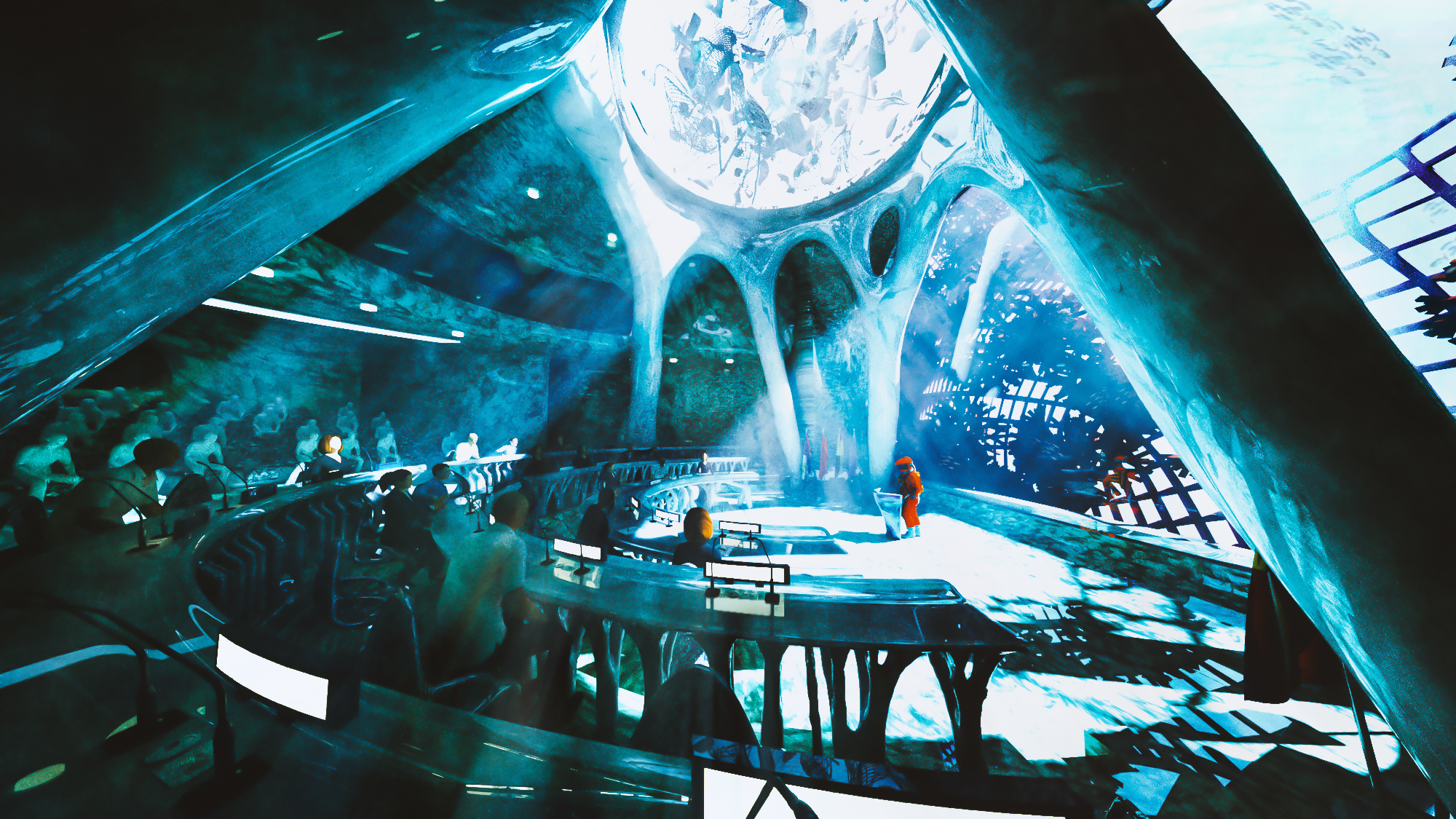 “The Ocean Regeneration Alliance becomes a beacon of hope in the South China Sea and seeks to create regional peace through cooperative ocean protection efforts. Reassessing our relationship with ocean plastics and oil rigs, and turning our problems into potential solutions.
“The Ocean Regeneration Alliance becomes a beacon of hope in the South China Sea and seeks to create regional peace through cooperative ocean protection efforts. Reassessing our relationship with ocean plastics and oil rigs, and turning our problems into potential solutions. “Dubbed “The Disk House”, the design of this circular, see-through residence, came as response to the Covid lockdown.The concept of the Disk House is to have 360 degrees views, with no sharp corners and no obstructive columns. “Being locked down for so many months now, made me realize how important the connection with the exterior is – and how much a glazed surface can do for you. Transparency is immaterial, hence your space always feels much larger and it creates a positive mental psyche”, says Karim.
“Dubbed “The Disk House”, the design of this circular, see-through residence, came as response to the Covid lockdown.The concept of the Disk House is to have 360 degrees views, with no sharp corners and no obstructive columns. “Being locked down for so many months now, made me realize how important the connection with the exterior is – and how much a glazed surface can do for you. Transparency is immaterial, hence your space always feels much larger and it creates a positive mental psyche”, says Karim. “This image represent one of the iconic architecture of Brutalism: the Georgia’s Deputy Minister of Highway Construction (today Bank of Georgia) located in Tblisi (Georgia). The concept of this work, ideally inspired by Christopher Herwing’s photography , is to restore luster to architectures “unexpectedly beautiful” of brutalism; from that the idea of conceiving the image as a postcard, extrapolating the architecture from its current decay context and make it the protagonist.
“This image represent one of the iconic architecture of Brutalism: the Georgia’s Deputy Minister of Highway Construction (today Bank of Georgia) located in Tblisi (Georgia). The concept of this work, ideally inspired by Christopher Herwing’s photography , is to restore luster to architectures “unexpectedly beautiful” of brutalism; from that the idea of conceiving the image as a postcard, extrapolating the architecture from its current decay context and make it the protagonist.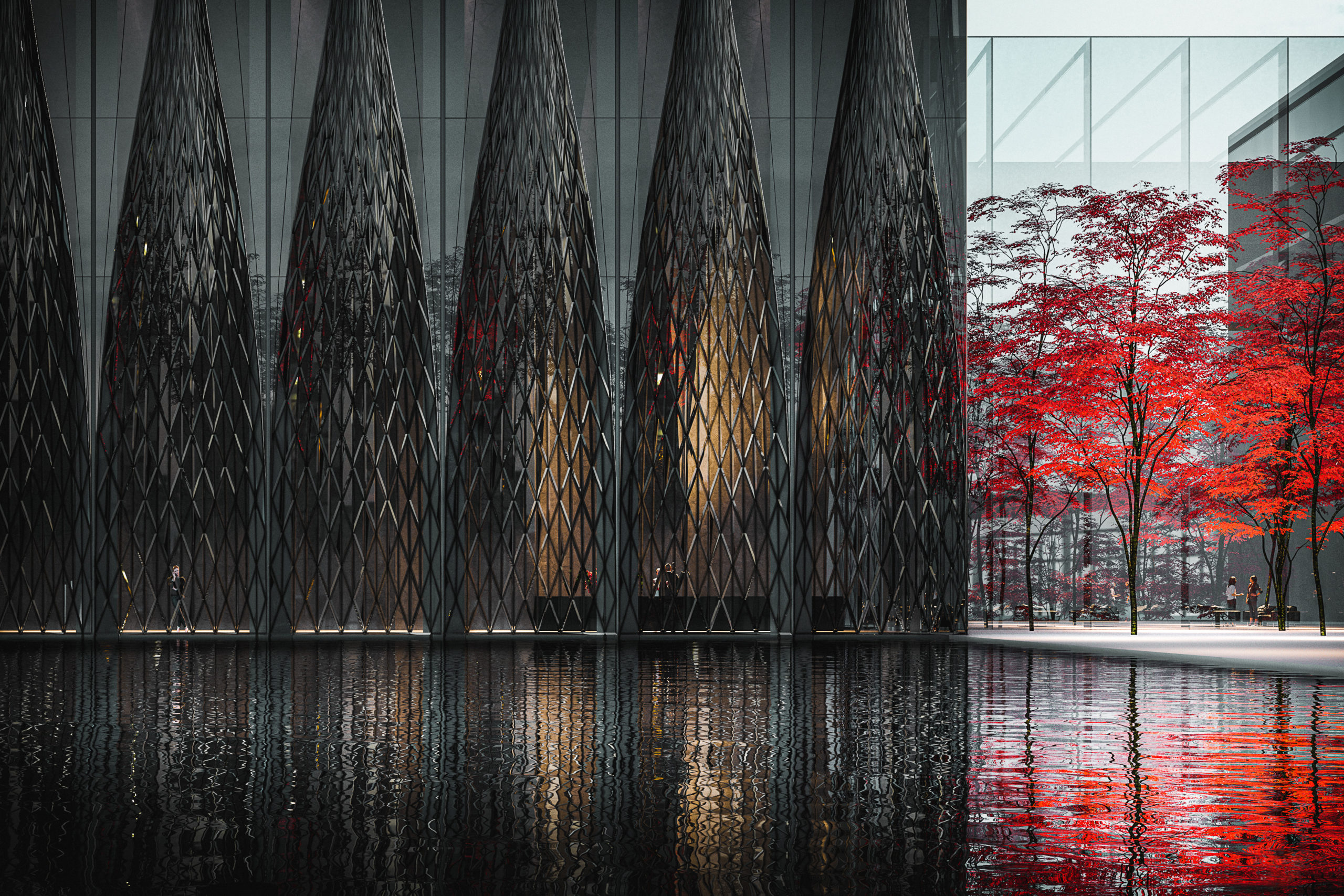 “The image has been created for a design competition featuring a high rise commercial development in Hudson Yards, New York. A rhythmic and geometric composition has been chosen over a more dramatic perspective to bring focus to the subtleties of the facade and lobby space behind.”
“The image has been created for a design competition featuring a high rise commercial development in Hudson Yards, New York. A rhythmic and geometric composition has been chosen over a more dramatic perspective to bring focus to the subtleties of the facade and lobby space behind.” “The LAX 2150 Spaceport imagines what the travel center may become as our civilization inevitably trends towards advancement. As technology becomes more complex and the population grows, new challenges arise for architectural planners. How will flying vehicles be accommodated? How will giant crowds move through LAX? How will climate pollution and sustainability be addressed?
“The LAX 2150 Spaceport imagines what the travel center may become as our civilization inevitably trends towards advancement. As technology becomes more complex and the population grows, new challenges arise for architectural planners. How will flying vehicles be accommodated? How will giant crowds move through LAX? How will climate pollution and sustainability be addressed? “- Hey! Im glad you could make it.
“- Hey! Im glad you could make it. “The image depicts a contemporary concept theater hall in Bulgaria’s capital city Sofia that stages the ballet dance performance called “Succubus”.
“The image depicts a contemporary concept theater hall in Bulgaria’s capital city Sofia that stages the ballet dance performance called “Succubus”. “Fourteen billion pounds of trash, most of it plastic, is carelessly dumped in the world’s oceans every year. The enormity of this waste problem requires an equally scaled solution. The Eden Initiative is a waste-to-energy plant that seeks to converge and address two of the greatest challenges confronting mankind today—pollution of our oceans and pollution of our atmosphere.
“Fourteen billion pounds of trash, most of it plastic, is carelessly dumped in the world’s oceans every year. The enormity of this waste problem requires an equally scaled solution. The Eden Initiative is a waste-to-energy plant that seeks to converge and address two of the greatest challenges confronting mankind today—pollution of our oceans and pollution of our atmosphere. “It will happen soon. Sooner than you expect.
“It will happen soon. Sooner than you expect.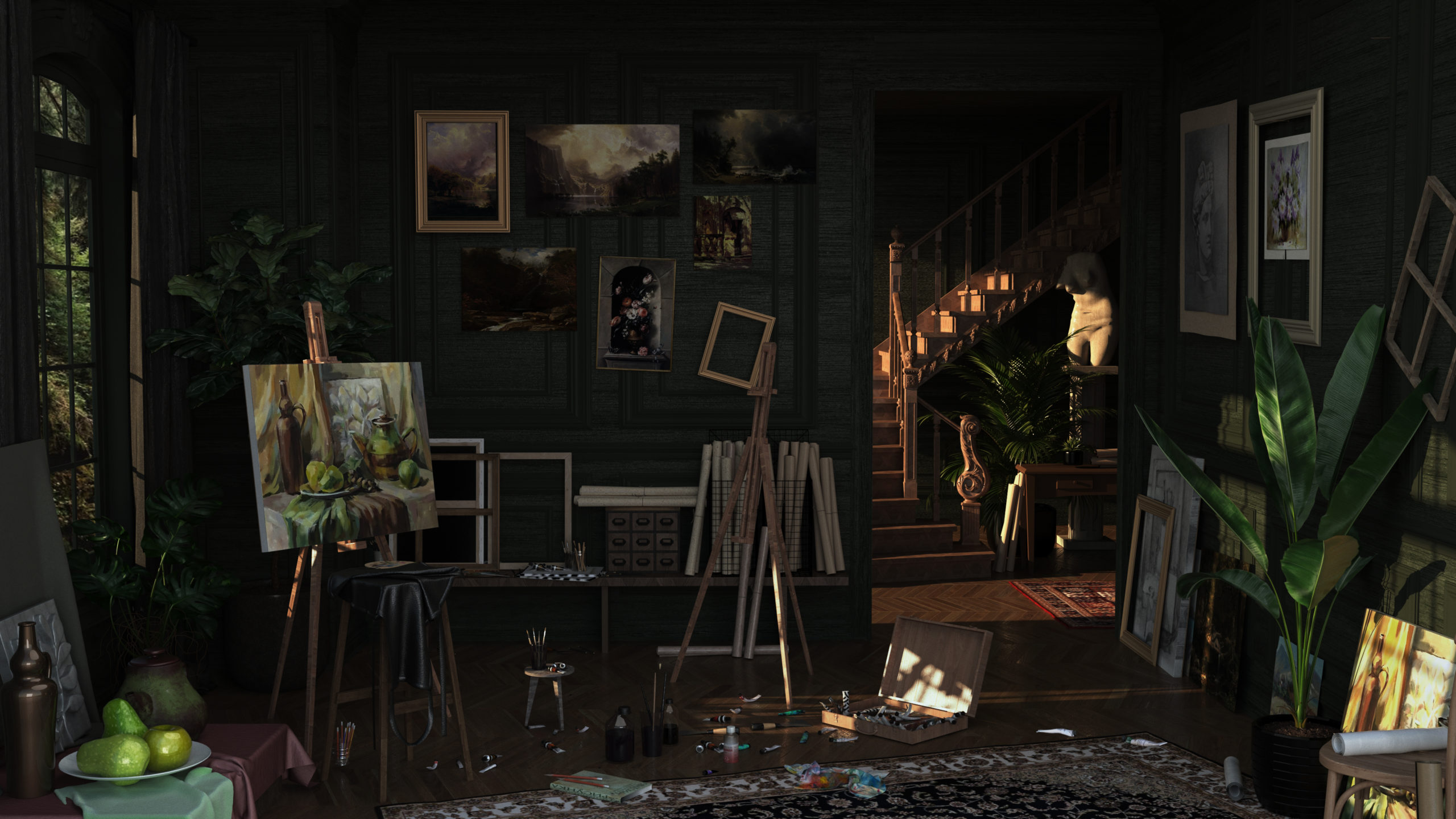 “An oil painter sets up a temporary studio in an empty Victorian drawing-room. Having the best light in the house, it will make a perfect temporary workspace. A rug is pushed to the back of the room as the space slowly fills with finished and unfinished works, half-used paint tubes and dirty paint water glasses. Rolls of paper overflow into the hallway, accompanying forgotten paintbrushes and drops of paint now soaked into the hardwood floor.
“An oil painter sets up a temporary studio in an empty Victorian drawing-room. Having the best light in the house, it will make a perfect temporary workspace. A rug is pushed to the back of the room as the space slowly fills with finished and unfinished works, half-used paint tubes and dirty paint water glasses. Rolls of paper overflow into the hallway, accompanying forgotten paintbrushes and drops of paint now soaked into the hardwood floor. “In a time not too far in the future, most of us people have already moved to the digital world of Metaverse. However, a lot of communities in our society are having some difficulty accepting the idea of this unusual and strange piece of technology.
“In a time not too far in the future, most of us people have already moved to the digital world of Metaverse. However, a lot of communities in our society are having some difficulty accepting the idea of this unusual and strange piece of technology. “In history, architecture has been an instrument to worship gods, emperors, and kings. In modern times, with a world moving towards a godless season, architecture hasn’t lost its symbolic value. The greatest locations are saved for those buildings that move people, gather them, and educate them. A temple of culture, a natural museum. Sitting on the coastline, in harmony with the rocky shore, showing a glittering skin like that of a giant snake sitting on the water. A strong palette of warm colors was the chosen to give a mystic atmosphere.”
“In history, architecture has been an instrument to worship gods, emperors, and kings. In modern times, with a world moving towards a godless season, architecture hasn’t lost its symbolic value. The greatest locations are saved for those buildings that move people, gather them, and educate them. A temple of culture, a natural museum. Sitting on the coastline, in harmony with the rocky shore, showing a glittering skin like that of a giant snake sitting on the water. A strong palette of warm colors was the chosen to give a mystic atmosphere.” “Surrealism is the new reality. Inspired by the masters of surrealism of Europe, the image shows a simple concept about the boundaries of the space, the beyond and the void.”
“Surrealism is the new reality. Inspired by the masters of surrealism of Europe, the image shows a simple concept about the boundaries of the space, the beyond and the void.” “Nothing more to do. Only darkness.”
“Nothing more to do. Only darkness.” “”In a reality where everything starts to melt into the same paradigm, the essence of differentiation shall resurface again.” In my rendering, I took an unorthodox approach in which I tried to fuse the abstractness of what I imagine about differentiation in the process of designing a structure in architecture. The iridescent glass structure above the white Mustang, resembles differentiation while also revealing the essence of creativity of architecture. Its surrounded by all concrete structures, depicting the monotony. The cubic structures above the same type of vehicle’s depict the exact same theme as the surrounding environment.”
“”In a reality where everything starts to melt into the same paradigm, the essence of differentiation shall resurface again.” In my rendering, I took an unorthodox approach in which I tried to fuse the abstractness of what I imagine about differentiation in the process of designing a structure in architecture. The iridescent glass structure above the white Mustang, resembles differentiation while also revealing the essence of creativity of architecture. Its surrounded by all concrete structures, depicting the monotony. The cubic structures above the same type of vehicle’s depict the exact same theme as the surrounding environment.” “The unity of nature and architectural form. The architecture seems to echo the shapes of the swans that live there, turning into waves and distorting the shape. It’s like a big stroke trying to unite the architecture with its surroundings by repeating it.”
“The unity of nature and architectural form. The architecture seems to echo the shapes of the swans that live there, turning into waves and distorting the shape. It’s like a big stroke trying to unite the architecture with its surroundings by repeating it.”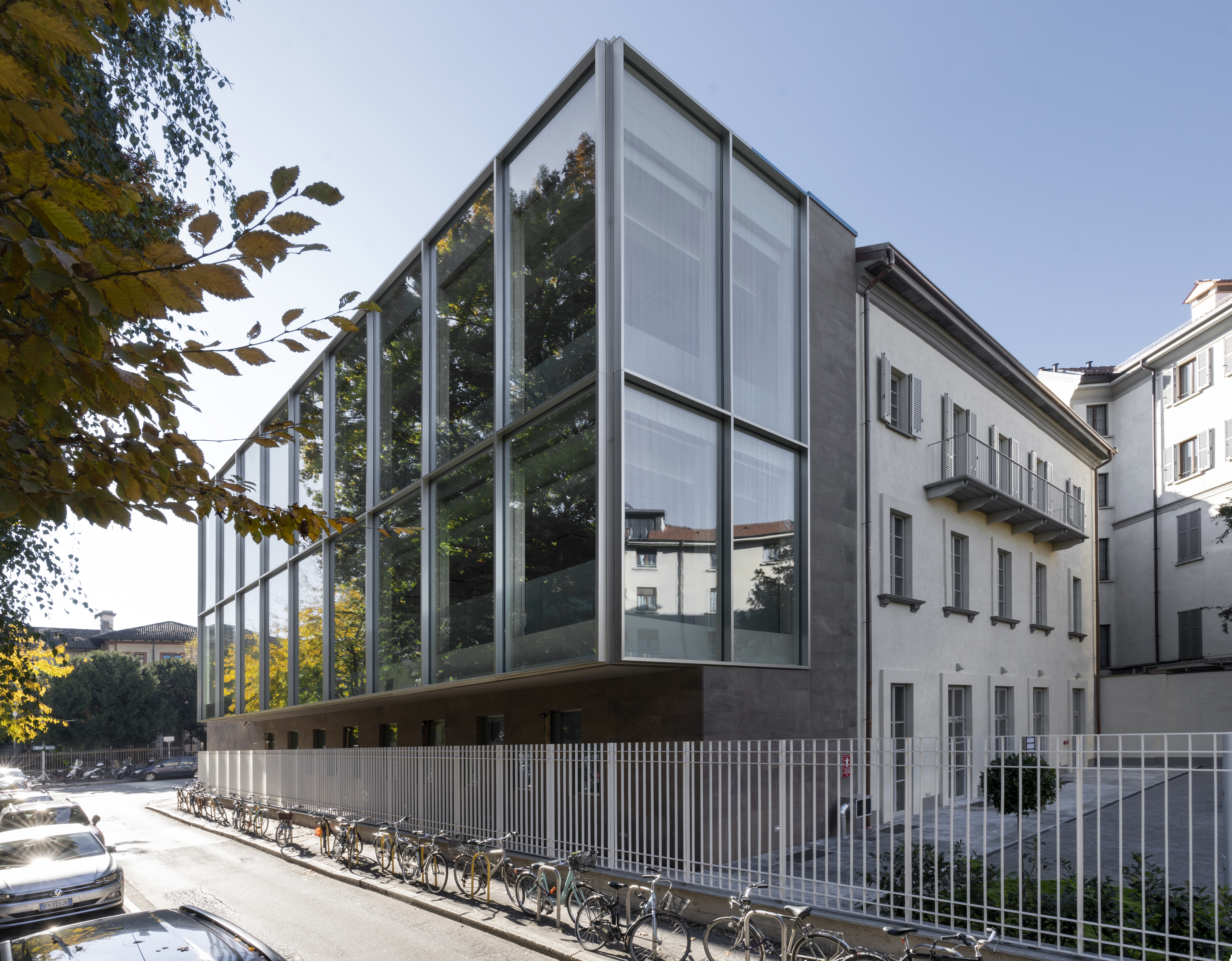



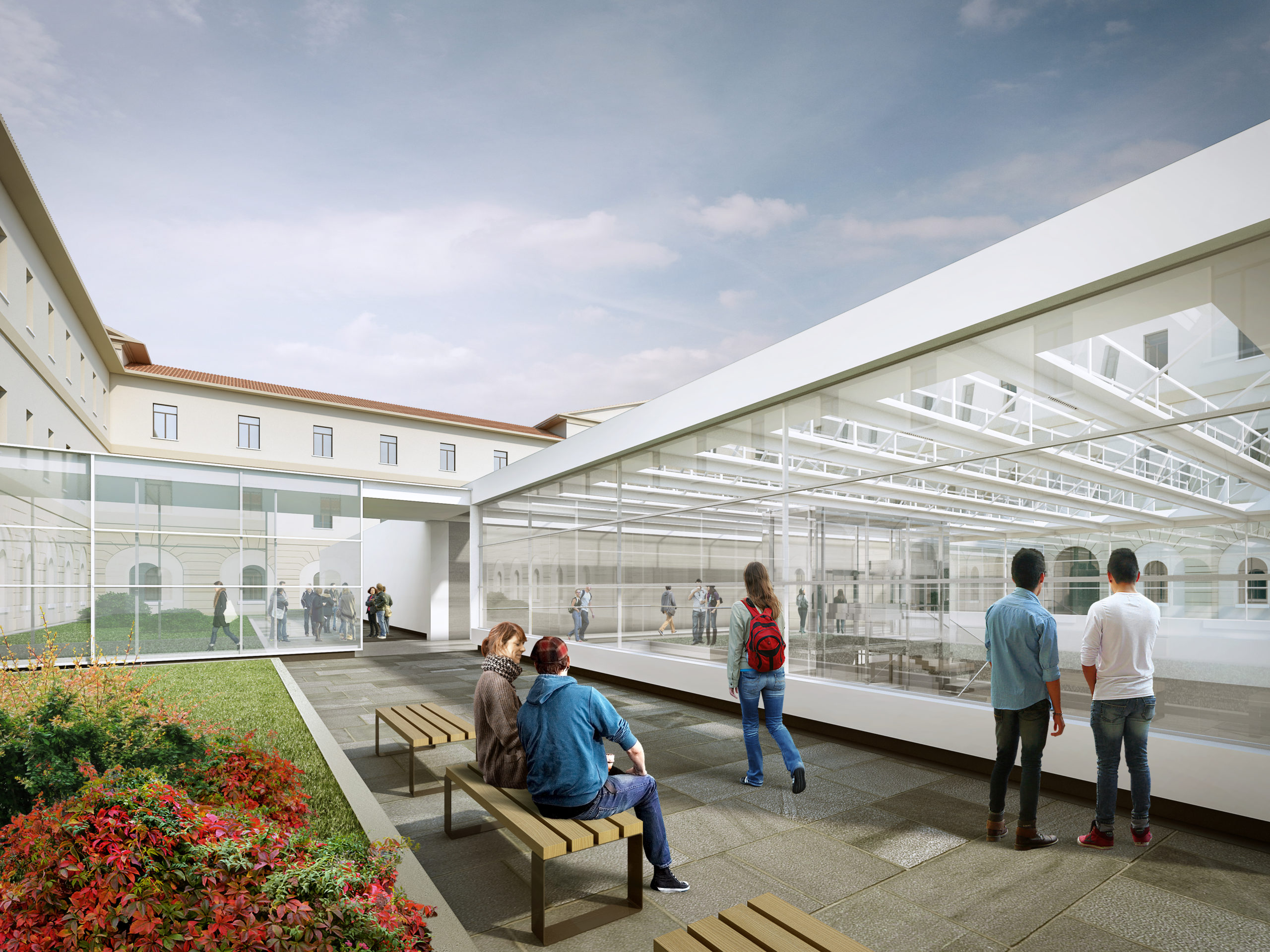
 From a restoration point of view, the project has a clear philological intent, bringing the monumental building back to its original consistency through the demolition of inconsistent buildings added over time, restoring the trend of the roof pitches and returning the height of the attics in the original positions (modified in the seventies).
From a restoration point of view, the project has a clear philological intent, bringing the monumental building back to its original consistency through the demolition of inconsistent buildings added over time, restoring the trend of the roof pitches and returning the height of the attics in the original positions (modified in the seventies).

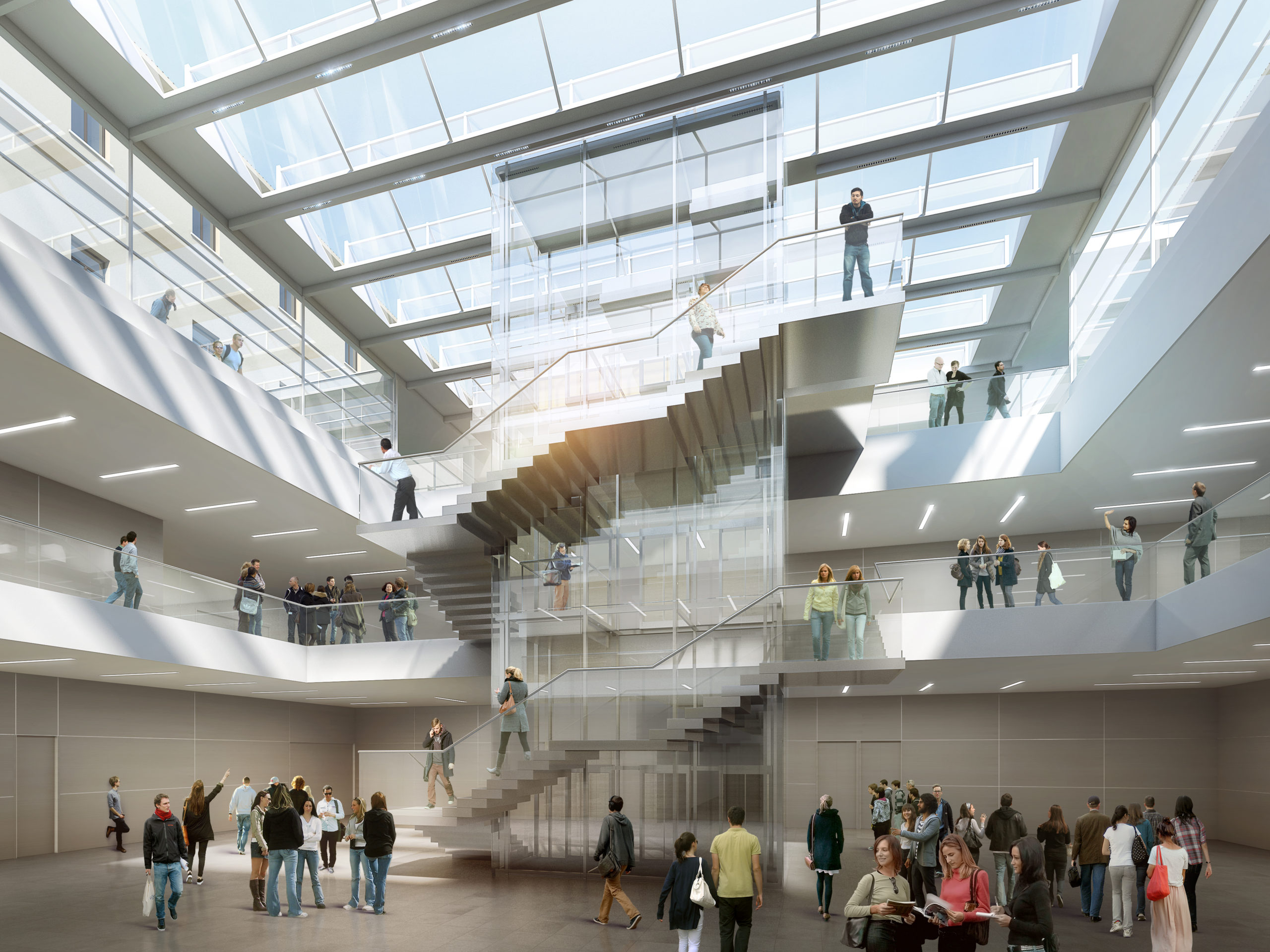
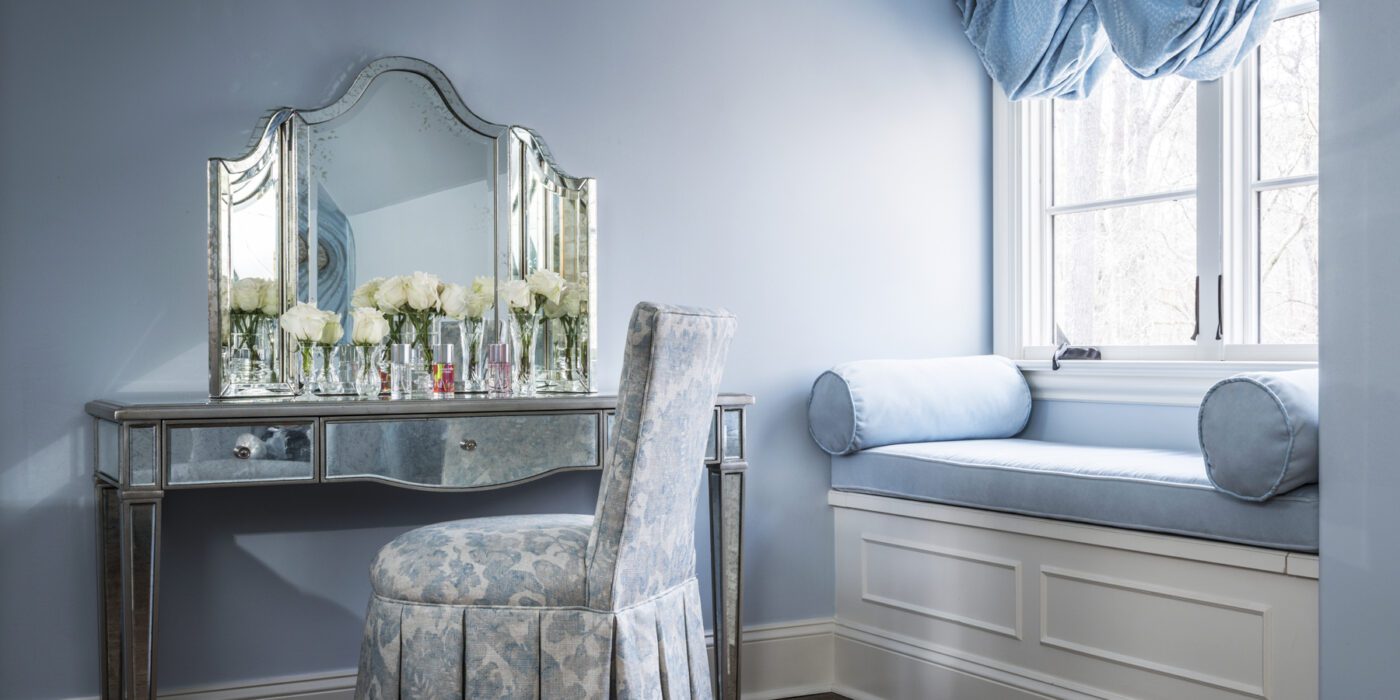








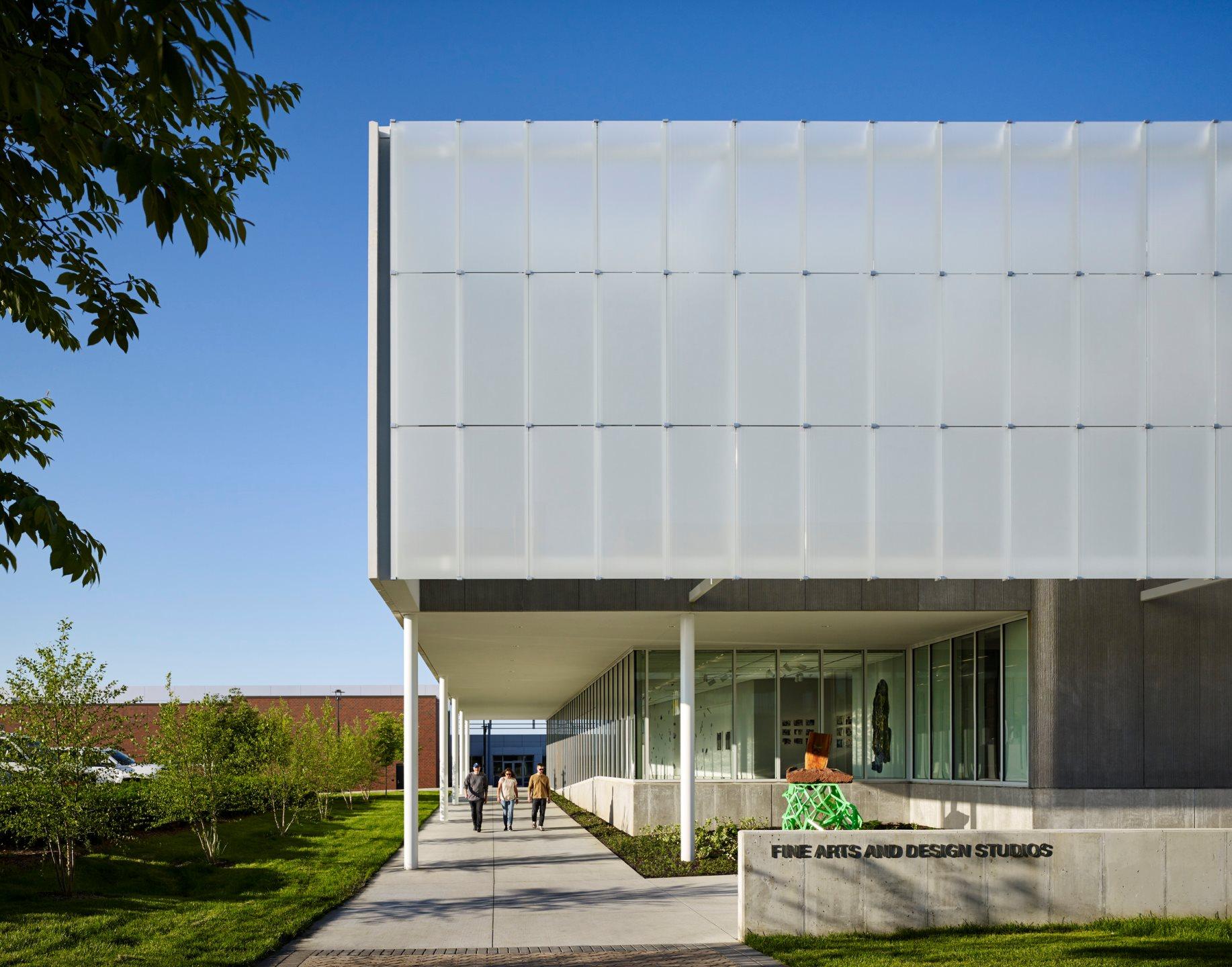
 At the heart of the FADS building is the idea of bringing diverse ideas and art practices together. The building was made to exemplify the notion of learning by doing, drawing together disciplines that were previously dispersed across campus: graphic design, sculpture, ceramics, metals, painting, drawing, photography and filmmaking. The architecture was designed to provide a framework for new synergies and enhanced collaboration and, in doing so, inspire creativity and new forms of art making.
At the heart of the FADS building is the idea of bringing diverse ideas and art practices together. The building was made to exemplify the notion of learning by doing, drawing together disciplines that were previously dispersed across campus: graphic design, sculpture, ceramics, metals, painting, drawing, photography and filmmaking. The architecture was designed to provide a framework for new synergies and enhanced collaboration and, in doing so, inspire creativity and new forms of art making.
 The FADS building was completed with
The FADS building was completed with 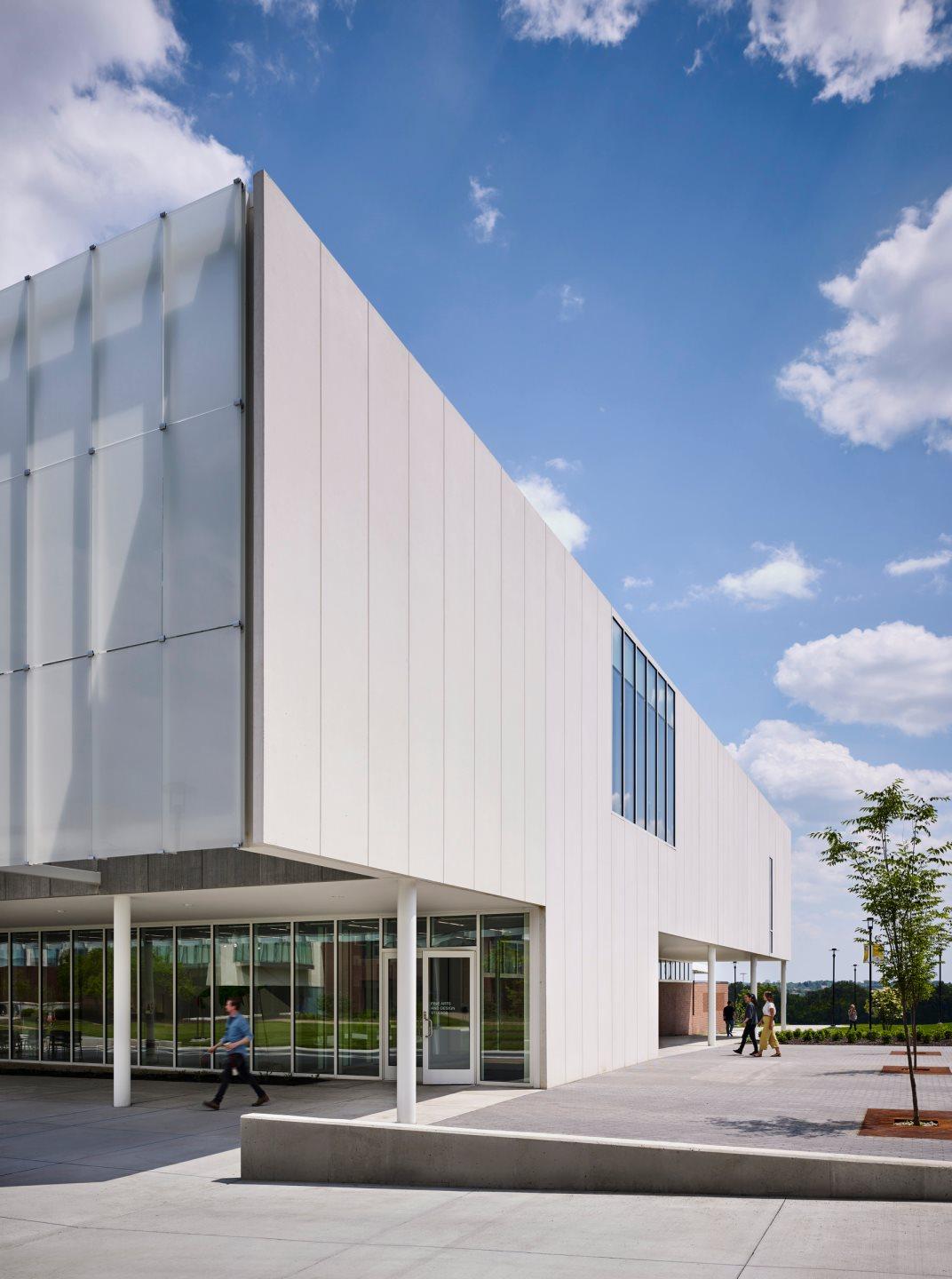
 As the design team notes, the FADS building included classrooms and studio space, material storage, multi-use common spaces, as well as display and collaboration spaces throughout building corridors. Fueling a desire to create, FADS includes these hallway gallery spaces and a covered outdoor courtyard, which functions as a year-round workspace for student and faculty artists alike.
As the design team notes, the FADS building included classrooms and studio space, material storage, multi-use common spaces, as well as display and collaboration spaces throughout building corridors. Fueling a desire to create, FADS includes these hallway gallery spaces and a covered outdoor courtyard, which functions as a year-round workspace for student and faculty artists alike.
 BNIM’s design features a rectangular volume lifted off the ground by a concrete podium and pilotis. In turn, the building volume is offset by acid-etched and ceramic-fritted glass panels. They worked with architectural glass and systems manufacturer Bendheim to bring the glass panels to life.
BNIM’s design features a rectangular volume lifted off the ground by a concrete podium and pilotis. In turn, the building volume is offset by acid-etched and ceramic-fritted glass panels. They worked with architectural glass and systems manufacturer Bendheim to bring the glass panels to life.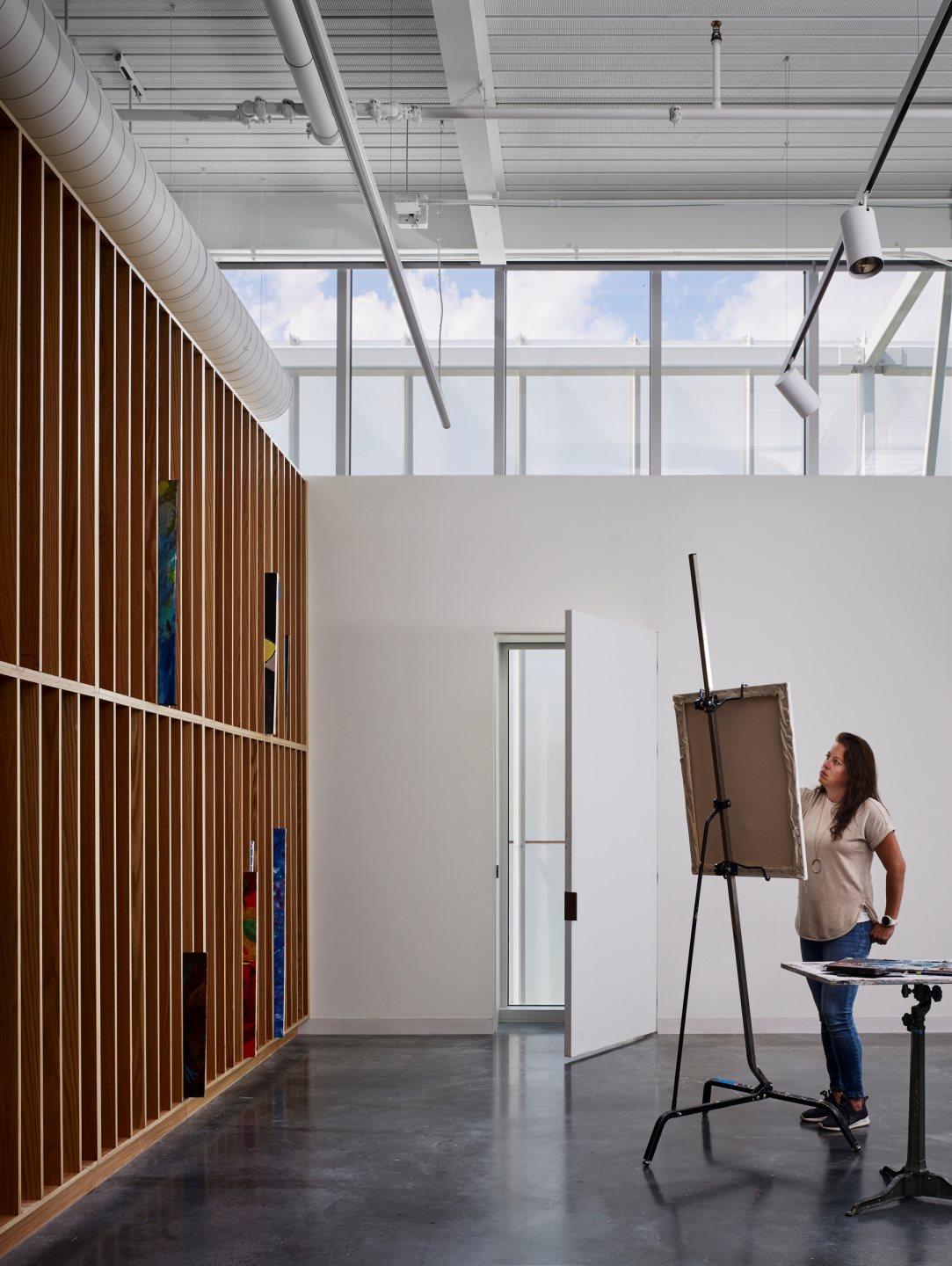
 Just steps away from the Midwest Trust Center, the Wylie Hospitality and Culinary Academy, and the Nerman Museum of Contemporary Art, the Fine Arts & Design Studios (FADS) facility was made to anchor a new arts neighborhood on campus. The FADS strengthens these connections and provides space to reimagine how art is made.
Just steps away from the Midwest Trust Center, the Wylie Hospitality and Culinary Academy, and the Nerman Museum of Contemporary Art, the Fine Arts & Design Studios (FADS) facility was made to anchor a new arts neighborhood on campus. The FADS strengthens these connections and provides space to reimagine how art is made.
 “In the fine arts are these silos of specialties, but the trend is to break through those silos,” says Fine Arts Professor Mark Cowardin. “Painters are embracing more materials, and sculptors are working with ceramics and drawing. We want that sort of cross-pollination, not only with our students but with our professors. We are encouraging a creativity zone where we can build on our reputation and present to our students the opportunity for innovation.”
“In the fine arts are these silos of specialties, but the trend is to break through those silos,” says Fine Arts Professor Mark Cowardin. “Painters are embracing more materials, and sculptors are working with ceramics and drawing. We want that sort of cross-pollination, not only with our students but with our professors. We are encouraging a creativity zone where we can build on our reputation and present to our students the opportunity for innovation.”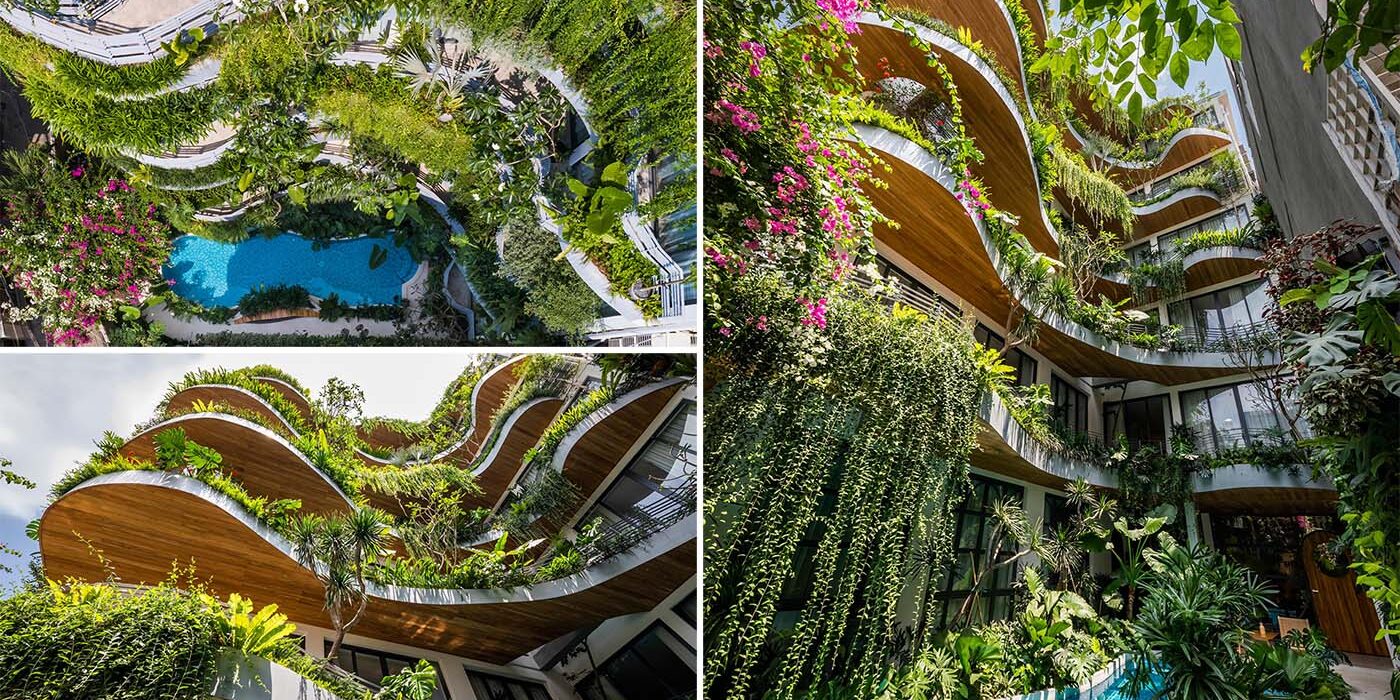
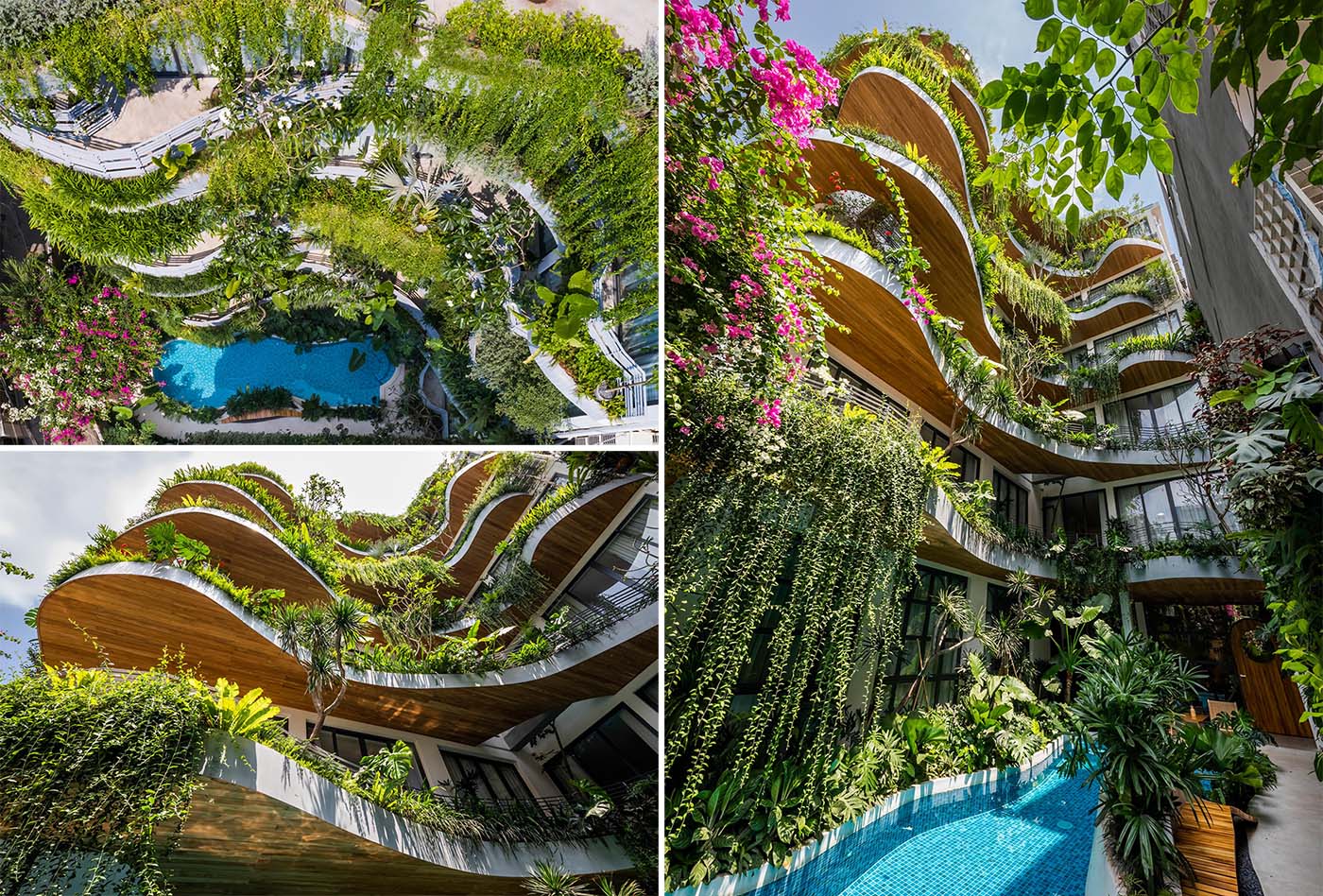
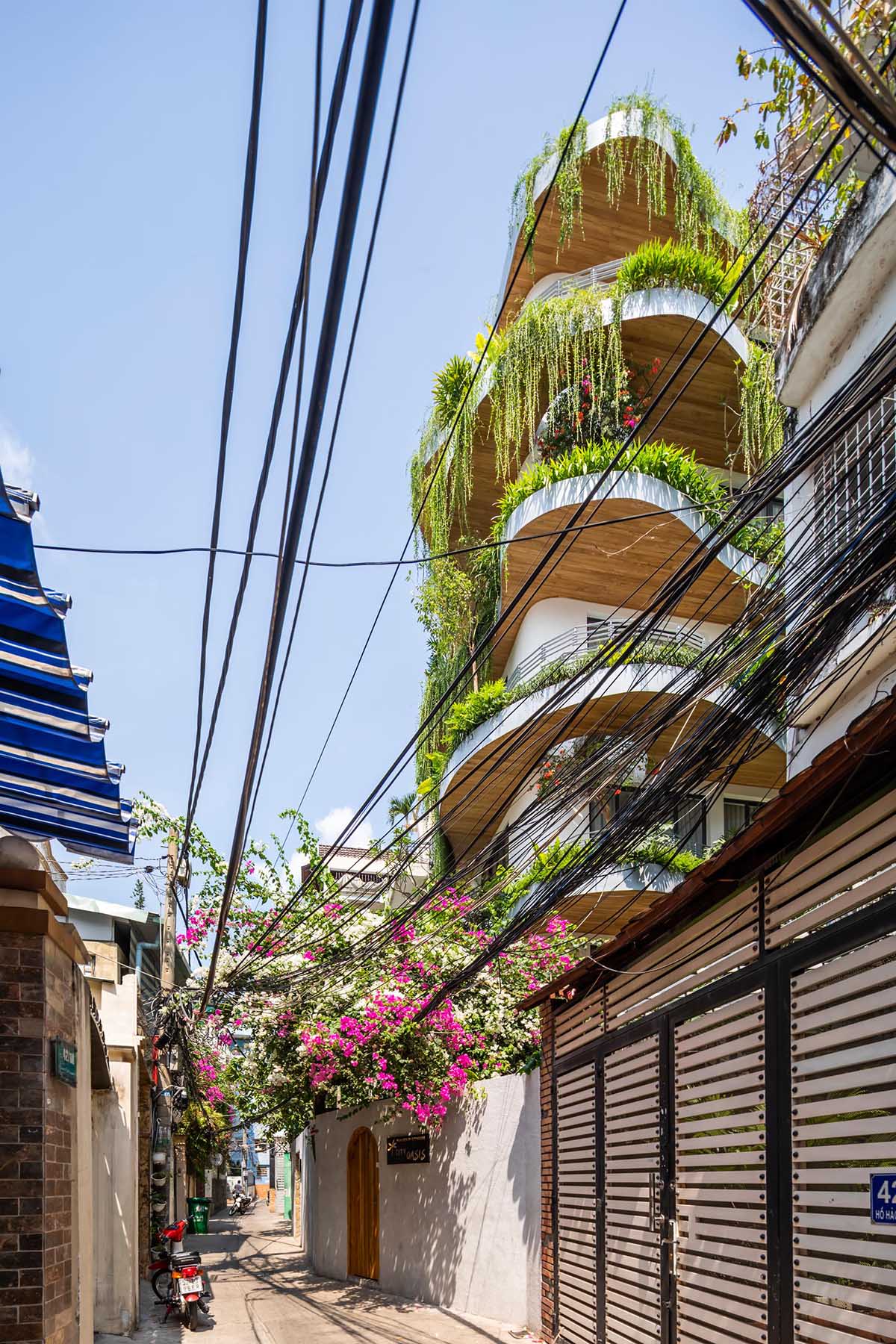





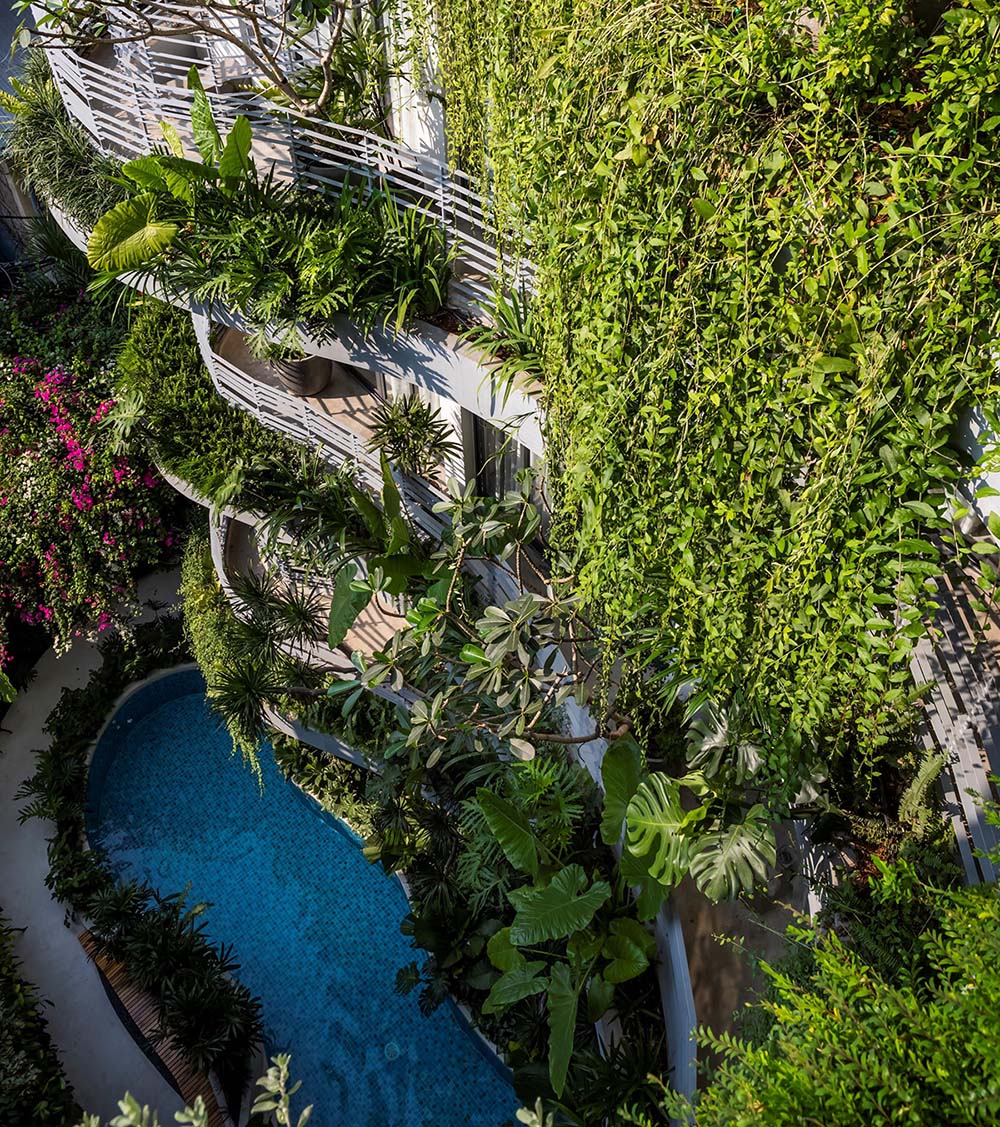

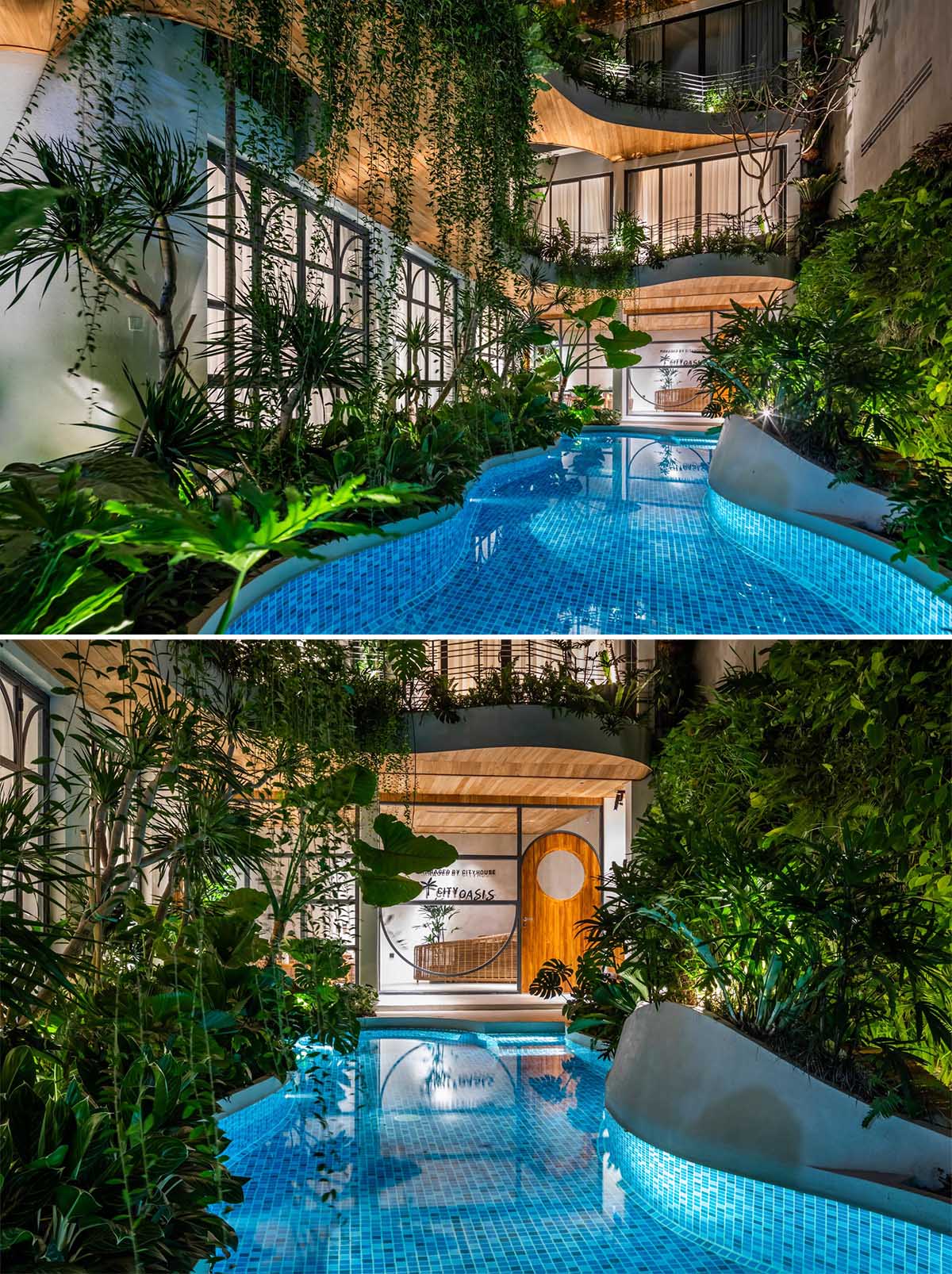






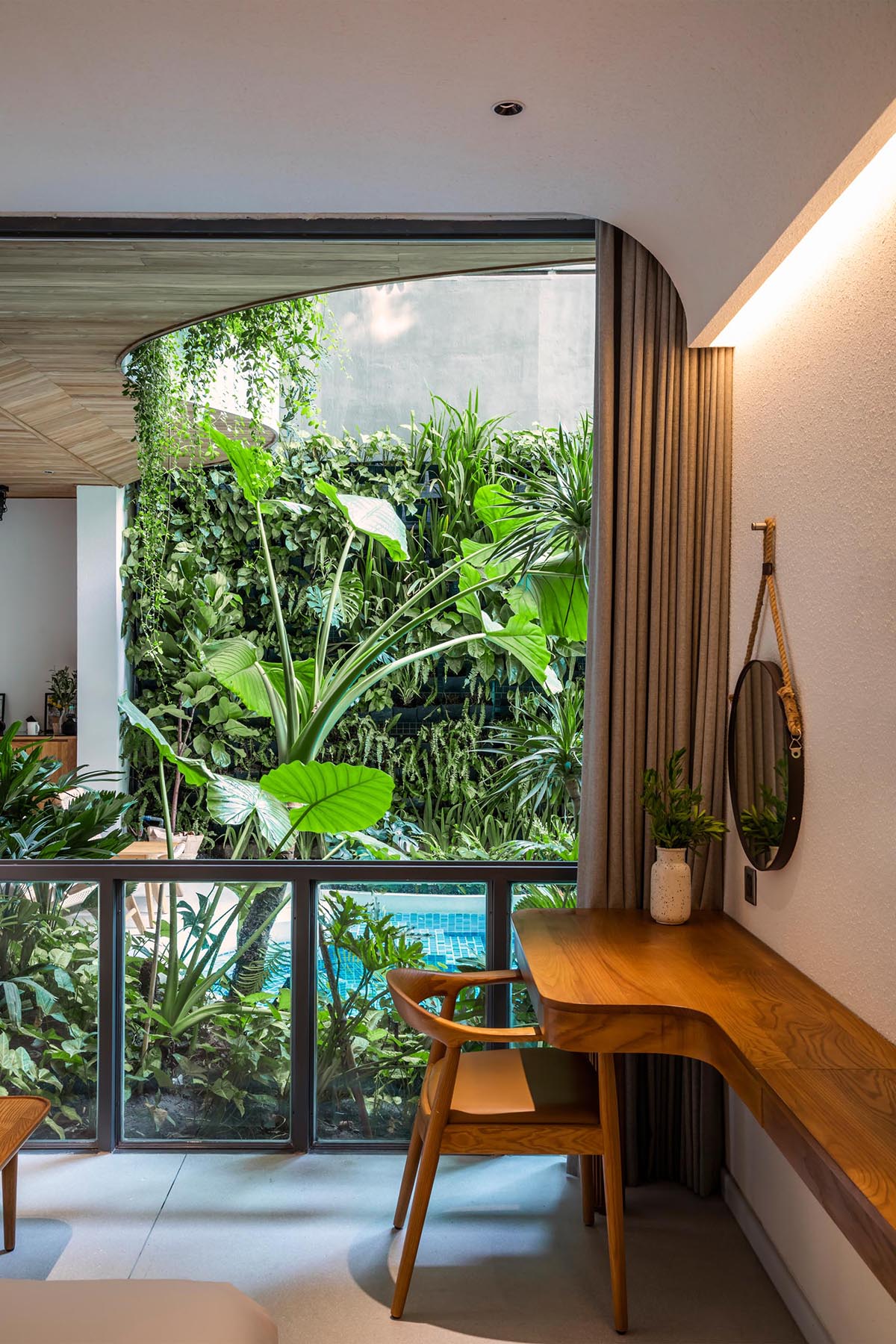



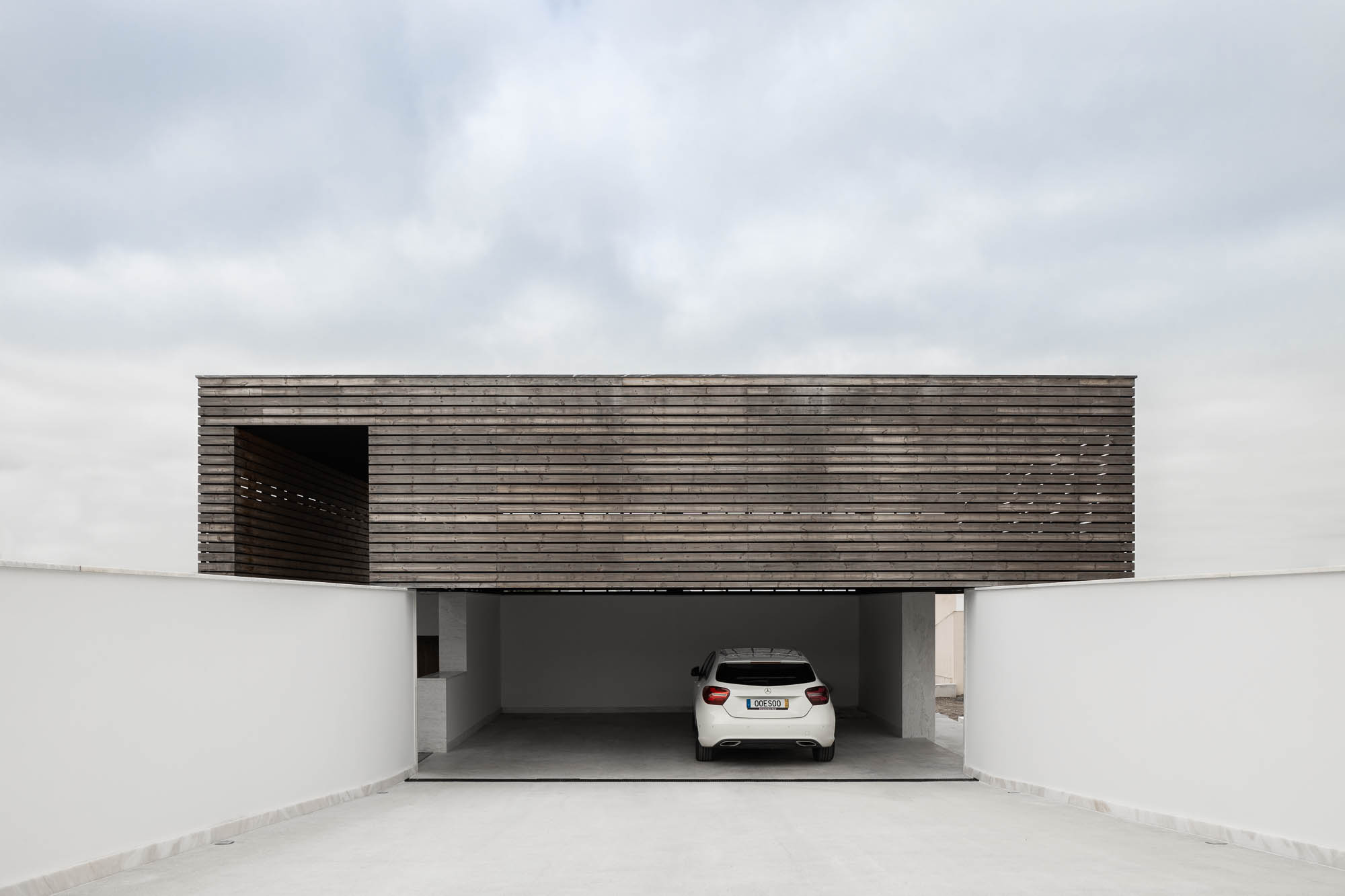






 Designed by PTW Architects, the National Swimming Centre in Beijing, also called Water Cube, has an iconic “bubbling” façade made of ETFE. To achieve this appearance, ETFE films are first welded together, then installed onto the steel frames and lastly filled with inert gases using the piped embedded in the steel frames to form cushions. The swimming pool is lit by natural light during the daytime and very little artificial lighting is needed, thanks to the transparency of ETFE.
Designed by PTW Architects, the National Swimming Centre in Beijing, also called Water Cube, has an iconic “bubbling” façade made of ETFE. To achieve this appearance, ETFE films are first welded together, then installed onto the steel frames and lastly filled with inert gases using the piped embedded in the steel frames to form cushions. The swimming pool is lit by natural light during the daytime and very little artificial lighting is needed, thanks to the transparency of ETFE.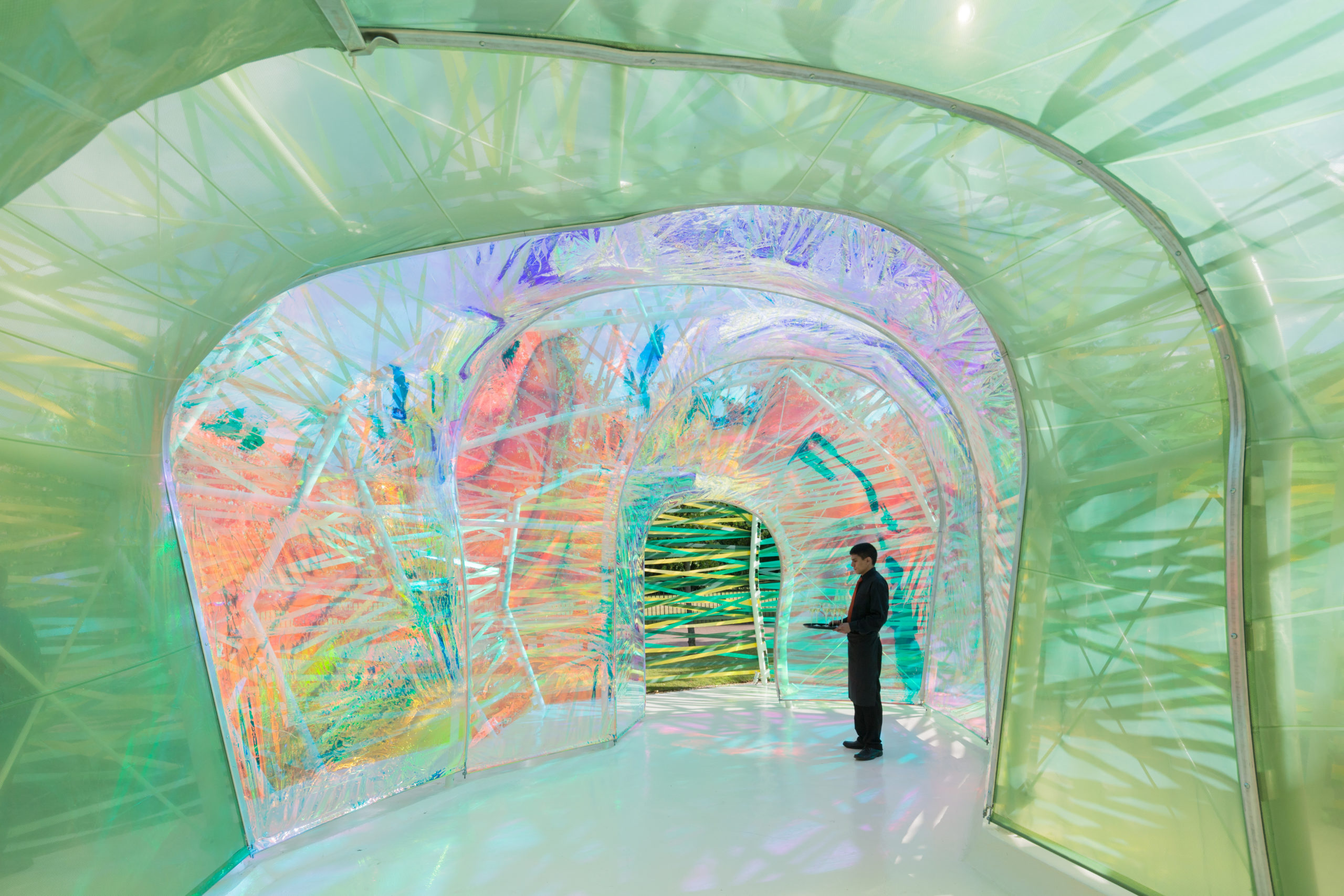 While Water Cube employs ETFE cushions for their environmental performance, the Serpentine Pavilion 2015 designed by SelgasCano plays with the material’s transparency. Using colored and color-diffusing ETFE films, joined by colored ribbons, the design team created a surreally colorful spatial experience. ETFE films and ribbons of different shades are attached to the steel skeleton, forming a double skin system where shades overlay building new shades and forms penetrate forming dreamy shadows. The lightness of the material allowed all skin sections to be installed by hand.
While Water Cube employs ETFE cushions for their environmental performance, the Serpentine Pavilion 2015 designed by SelgasCano plays with the material’s transparency. Using colored and color-diffusing ETFE films, joined by colored ribbons, the design team created a surreally colorful spatial experience. ETFE films and ribbons of different shades are attached to the steel skeleton, forming a double skin system where shades overlay building new shades and forms penetrate forming dreamy shadows. The lightness of the material allowed all skin sections to be installed by hand.
 The Ice Stadium Schierker Feuerstein-Arena designed by GRAFT stands out in the competition to renovate the stadium for its unique roof. The roof of over 29,000 square feet (2, 700 sq. m) spans across the ice rink, meeting the ground at its two ends. The lightweight yet strong PTFE membrane rests on a net of steel ropes which is then fixed to the outer steel frame. The structure bears wind, rain and snow and sheltered the stadium from direct sunlight by diffusing it. During the night, the reflectivity of the material spreads lights across the whole roof, multiplying the artificial lighting.
The Ice Stadium Schierker Feuerstein-Arena designed by GRAFT stands out in the competition to renovate the stadium for its unique roof. The roof of over 29,000 square feet (2, 700 sq. m) spans across the ice rink, meeting the ground at its two ends. The lightweight yet strong PTFE membrane rests on a net of steel ropes which is then fixed to the outer steel frame. The structure bears wind, rain and snow and sheltered the stadium from direct sunlight by diffusing it. During the night, the reflectivity of the material spreads lights across the whole roof, multiplying the artificial lighting.